What is the best concealed carry gun? Spoiler alert — there isn’t one.
The real question you should be asking is, “What is the best concealed carry gun for me?“
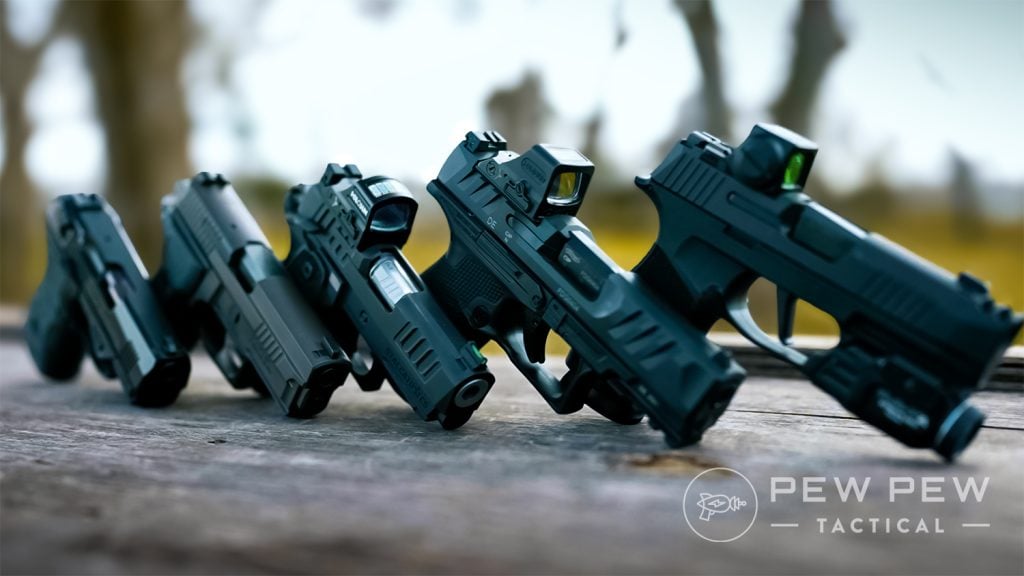
People who choose to carry come in all shapes, sizes, and skill levels. Sometimes it may just come down to what you are wearing that day.
All these factors mean different market feedback, which is reflected in the sheer amount of different guns available.

Whether you’re a first-time buyer or an experienced gun owner looking to expand your collection, our comprehensive list is tailored to help you find the perfect firearm for self-defense, personal safety, and recreational shooting.
We’ll help you understand what makes a great concealed carry gun, and how to choose one that fits your lifestyle and experience level.
Keep reading!
THE QUICK LIST
-
Best Overall Concealed Carry Gun
-
Best Micro Compact 9mm for Concealed Carry
-
Best Compact 9mm
-
Best .380 ACP
-
Best Concealed Carry Revolver
-
Best High-End Concealed Carry Gun
-
Best Budget Concealed Carry Gun
Table of Contents
Loading…
Concealed Carry Handguns Comparison Chart
| Model | Caliber | Barrel Length | Overall Length | Weight | Capacity | Price |
| Sig Sauer P365 X-Macro | 9mm | 3.7″ | 6.6″ | 27 oz | 17+1 | $669 |
| Springfield Armory Hellcat | 9mm | 3″ | 6″ | 17.9 oz | 11+1 | $499 |
| Walther PDP Compact | 9mm | 4″ | 7.5″ | 21.4 oz | 15+1 | $599 |
| Smith & Wesson Bodyguard 2.0 | .380 ACP | 2.75″ | 5.5″ | 9.8 oz | 12+1 | $399 |
| Kimber K6s | .357 Magnum | 2″ | 6.62″ | 23 oz | 6 | $784 |
| Staccato CS | 9mm | 3.5″ | 7.1″ | 23 oz | 15+1 | $2,499 |
| Glock 30 | .45 ACP | 3.78″ | 6.97″ | 26.2 oz | 10+1 | $449 |
| Canik TP9 Elite SC | 9mm | 3.6″ | 6.7″ | 24.8 oz | 12+1 | $399 |
How We Tested the Best Concealed Carry Pistols
For this article, we gathered a bunch of pistols we’ve personally shot, reviewed, and owned here at Pew Pew Tactical. All guns that made this list had to have a few things in common to earn a spot on our best concealed carry handgun recommendations:
- Must reliably fire
- Must be easy to use and maintain.
- Ergonomics must work for most shooters.
- Must have a price tag that the average consumer can stomach.
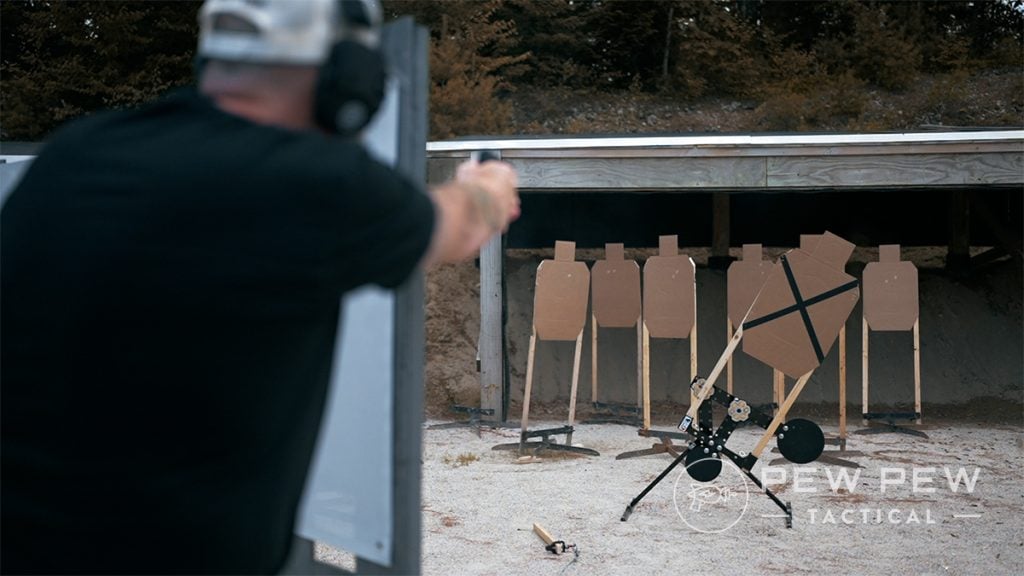
The entire Pew Pew Tactical team, as well as freelance writers, contributed to this review to offer different opinions based on hand size and body type. Everyone on our team has tested and carried every gun on this list.
For guns we have reviews on, we’ve linked those so you can read more. Every review gun undergoes a strict testing protocol that requires a minimum of 500 rounds of both FMJ and JHP ammo through it at 5 and 7 yards. Most of the guns listed have seen 1,000+ rounds through them at longer distances and have been used for everyday concealed carry with a member of our staff.
Best CCW Handguns
1. Sig Sauer P365 X-Macro – Best Overall Concealed Carry Gun
Prices accurate at time of writing
Prices accurate at time of writing
-
25% off all OAKLEY products - OAKLEY25
Copied! Visit Merchant
Pros
- Highly customizable
- Optics-ready
- 17-round capacity
- Excellent sights
Cons
- Trigger is gritty and mushy
- Grip texture ends low on frame
Specs
- Caliber: 9mm
- Capacity: 17+1
- Barrel Length: 3.7 inches
- Overall Length: 6.6 inches
- Height: 4.8 inches
- Width: 1.1 inches
- Weight: 27 oz (fully loaded)
Sig has been leading the micro-compact charge with its ultra-successful P365 series. These guns are just over an inch thick, but depending on the particular model, they boast anywhere from a 10-round (P365) to a whopping 17-round capacity (X-Macro).
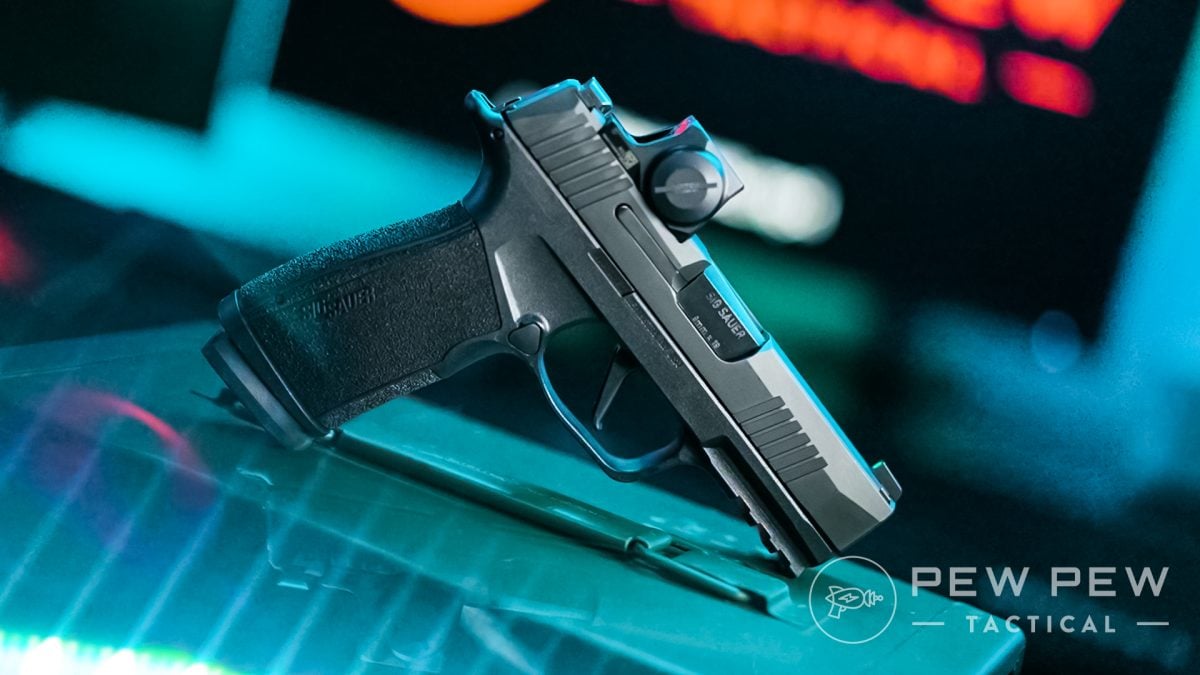
While our team owns just about every P365 under the sun (the base P365, P365XL, P365 Spectre XL Comp, P365 Rose), we keep coming back to the P365 X-Macro as our favorite.
The XMacro fits nicely in my medium-sized hands with a full-size grip that even larger-handed folks can appreciate. The larger size also means more capacity — 17+1 to be specific.
On top of offering a good grip surface and plenty of rounds, the XMacro also shoots extremely well. It delivers great accuracy and is also relatively easy to shoot. Our team had no issues getting solid groupings during testing.
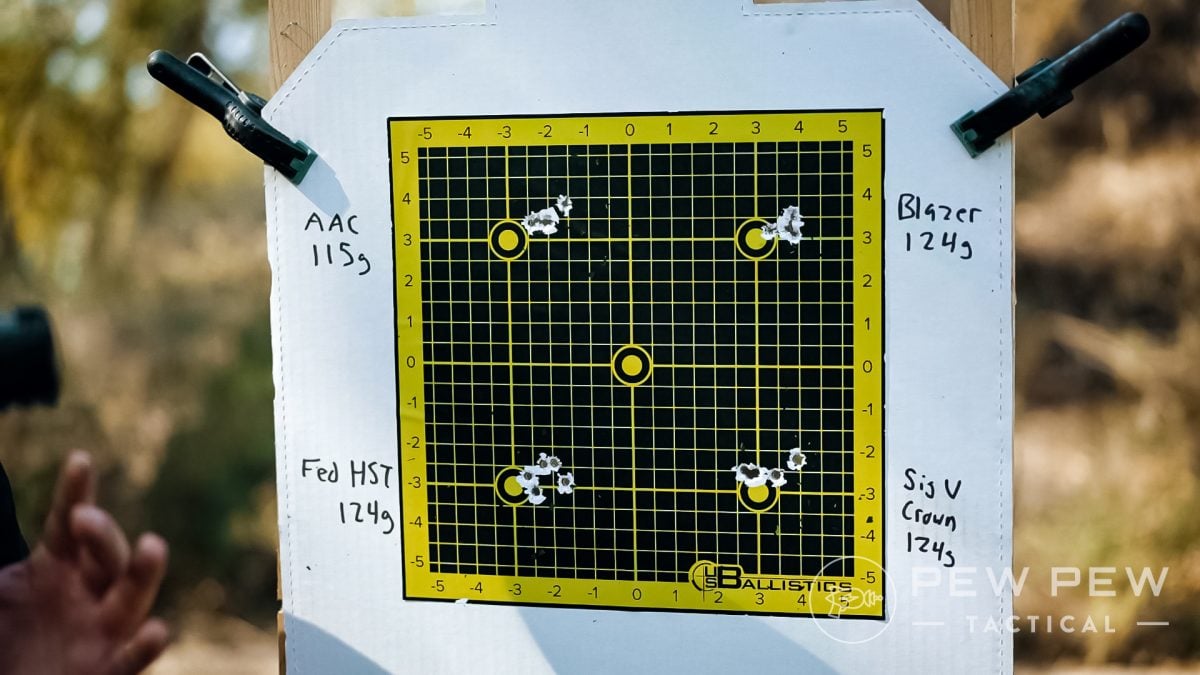
Additionally, the P365’s modularity and rapidly growing aftermarket have pushed it even further, making it one of the most supported guns on the market today.
The P365 series offers excellent ergonomics, good triggers, OEM night sights, and solid accuracy and reliability, which have propelled these to the top spot for many gun owners worldwide.
In fact, it gets a 4.3 out of 5 stars in our Pew Pew Meter rating system.


If you need to dig in more and get all the details on the Sig P365 XMacro, we have a written review that goes in-depth on our testing and results. Or, if written isn’t your thing, check out our video review below to see it action.
What do you think of the Sig P365 XMacro? Rate it below!
2. Springfield Armory Hellcat – Best Micro Compact 9mm for Concealed Carry
Prices accurate at time of writing
Prices accurate at time of writing
-
25% off all OAKLEY products - OAKLEY25
Copied! Visit Merchant
Pros
- Great for concealment
- Aggressive texturing
- Easy to shoot
- Great iron sights
Cons
- May be too small for larger hands
- Less aftermarket support
- Snappier than other micro compacts
Specs
- Caliber: 9mm Luger
- Capacity: 11+1 rounds, 13+1 rounds
- Barrel Length: 3 inches
- Overall Length: 6 inches / 7 inches
- Height: 4 inches
- Width: 1 inch
- Weight: 17.9 oz
Much like the Sig P365, the Springfield Hellcat is another top-tier option for those wanting a micro-compact.
A standard capacity of 11+1 gives it a slight capacity advantage over the base P365, but that’s not all.
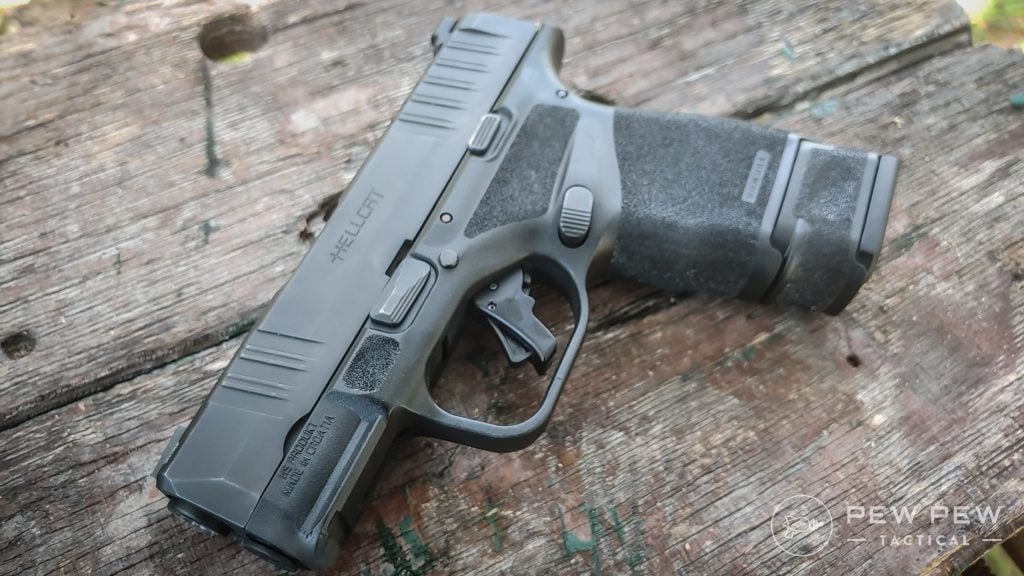
As a P365 owner, I wasn’t sure how much I would like the Hellcat. After having shot a few different versions and examples, I can say that it stacks up.
In my opinion, the Hellcat’s factory U-notch rear and tritium front sight is one of the best stock sight setups on the market. If that doesn’t tickle your fancy, you can toss a micro red dot on the optics-ready models.
The trigger is not as light as the P365, but I find it more consistent across different guns. Accuracy has been great for me, whether I am doing 7-yard Mozambique drills or 40-yard Dicken drills.
Aggressive grip texturing, a crisp trigger, optional 13-round extended mags, and overall solid performance make the Hellcat a homerun choice.
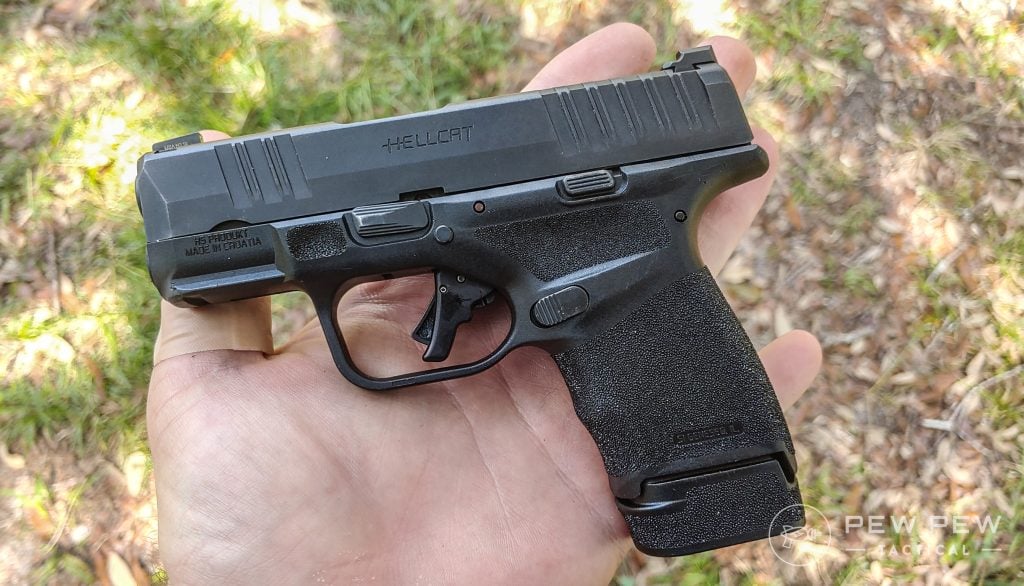
After extensive trigger time behind both the P365 and the Hellcat, I can confidently say, “Pick whichever one feels best.”
The Hellcat is a performer, and most of our readers rate it highly, netting an average of 4.7 out of 5 stars in Pew Pew Meter.


You can read up on our full review of the Hellcat. If you have some things to say about the Hellcat, drop a review in Pew Pew Meter with your thoughts!
3. Walther PDP Compact – Best Compact 9mm for Concealed Carry
Prices accurate at time of writing
Prices accurate at time of writing
-
25% off all OAKLEY products - OAKLEY25
Copied! Visit Merchant
Pros
- Excellent trigger
- Optics ready
- Ambidextrous
- Extremely accurate
Cons
- High bore axis
- Optics plates must be ordered through Walther
Specs
- Caliber: 9mm Luger
- Capacity: 15+1 rounds
- Barrel Length: 4 inches / 5 inches
- Overall Length: 7.5 inches / 8.5 inches
- Height: 5.4 inches
- Width: 1.34 inches
- Weight: 21.4 oz
We love Walther at Pew Pew Tactical, and it is no secret, but with good reason.
The PDP Compact is a true Glock 19-sized compact gun that can double as a duty gun or a concealed carry piece.
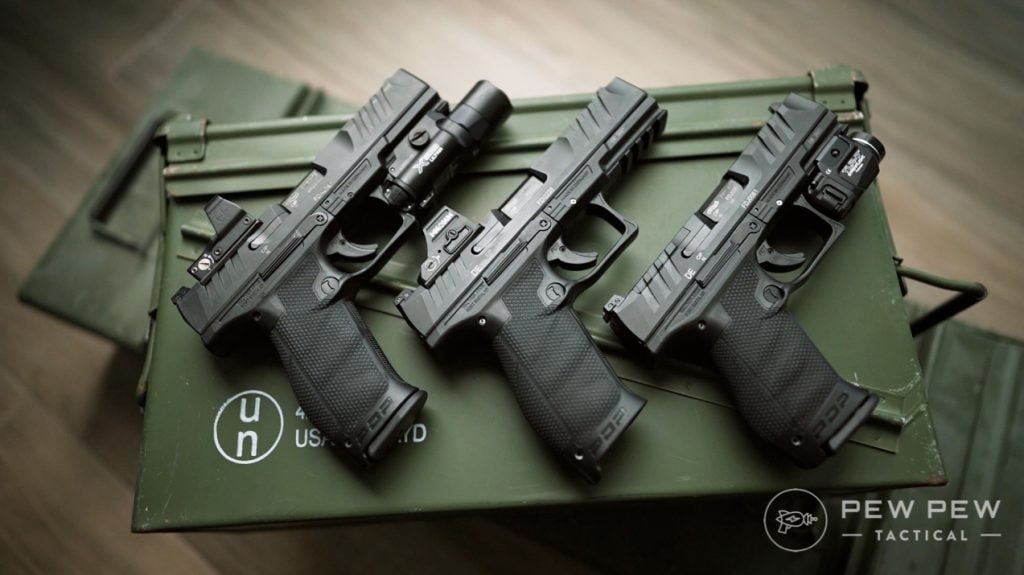
What places the PDP above its peers is the exquisite Performance Duty Trigger — a crisp 4-pound trigger with a clean break, almost no overtravel, and a very short reset.
Trigger aside, you get an optics-ready pistol that is boringly reliable, dead-nuts accurate, and extremely ergonomic.
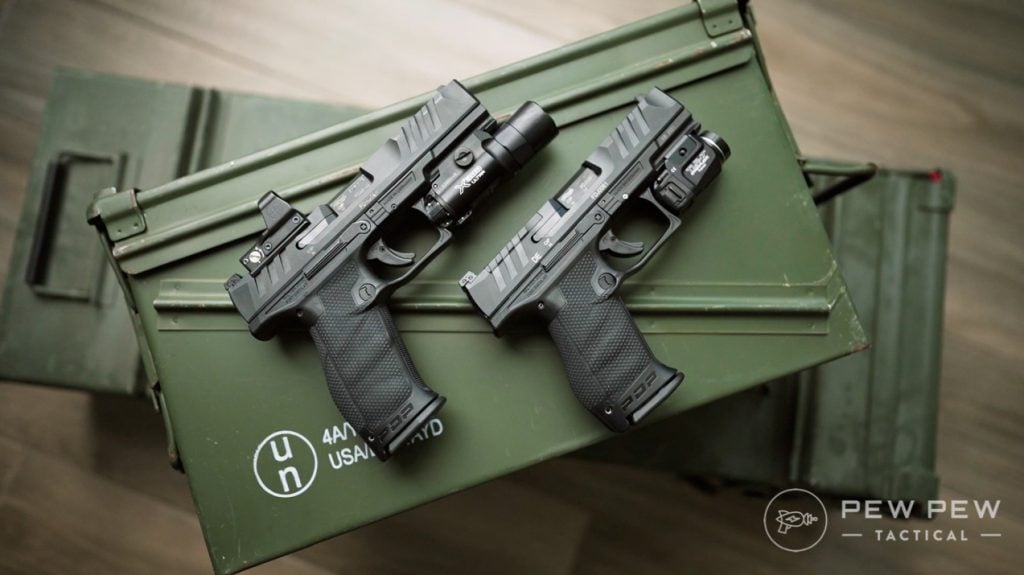
For concealed carry, the 4-inch barreled compact model with the 15-round compact grip module is my personal choice.
The PDP can trace its design roots all the way back to the P99. This means that the PDP’s core operating system has been proven for over 25 years.
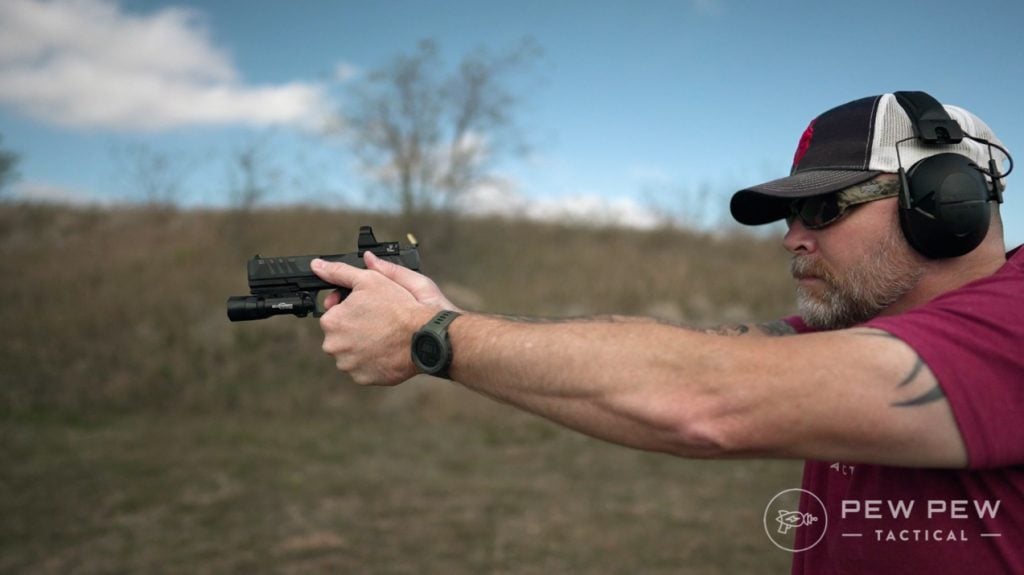
When push comes to shove, I find these guns to be the best in class, and the aftermarket is robust enough to support your carry endeavors. I frequently recommend them, and it’s one of my most trusted duty guns.
Our readers also dig it too, scoring it 4.8 out of 5 stars. Feel free to leave your own review!


Even better, Walther has been steadily expanding the PDP line-up, adding more models to the series. We have had a chance to check out the PDP F, which works best for slimmer hands, and the PDP Match, suited for competition.
We went 10,000 rounds with the Walther PDP, watch the video below to see it unfold!
4. Smith & Wesson Bodyguard 2.0 – Best .380 ACP for Concealed Carry
Prices accurate at time of writing
Prices accurate at time of writing
-
25% off all OAKLEY products - OAKLEY25
Copied! Visit Merchant
Pros
- Easily concealed
- Good ergonomics
- Solid trigger
Cons
- Challenging for big hands
- Not designed for accessories
- Caliber: .380 ACP
- Capacity: 12+1
- Barrel Length: 2.75 inches
- Overall Length: 5.5 inches
- Height: 4 inches
- Width: 0.88 inches
- Weight: 9.8 oz
Now, you might see the name “Bodyguard” and instantly recoil. We get it. The original Smith & Wesson Bodyguard was a snappy .380 ACP with one of the worst triggers you could imagine.
Luckily, Smith & Wesson fine-tuned the platform and released a new and improved version called the Bodyguard 2.0.
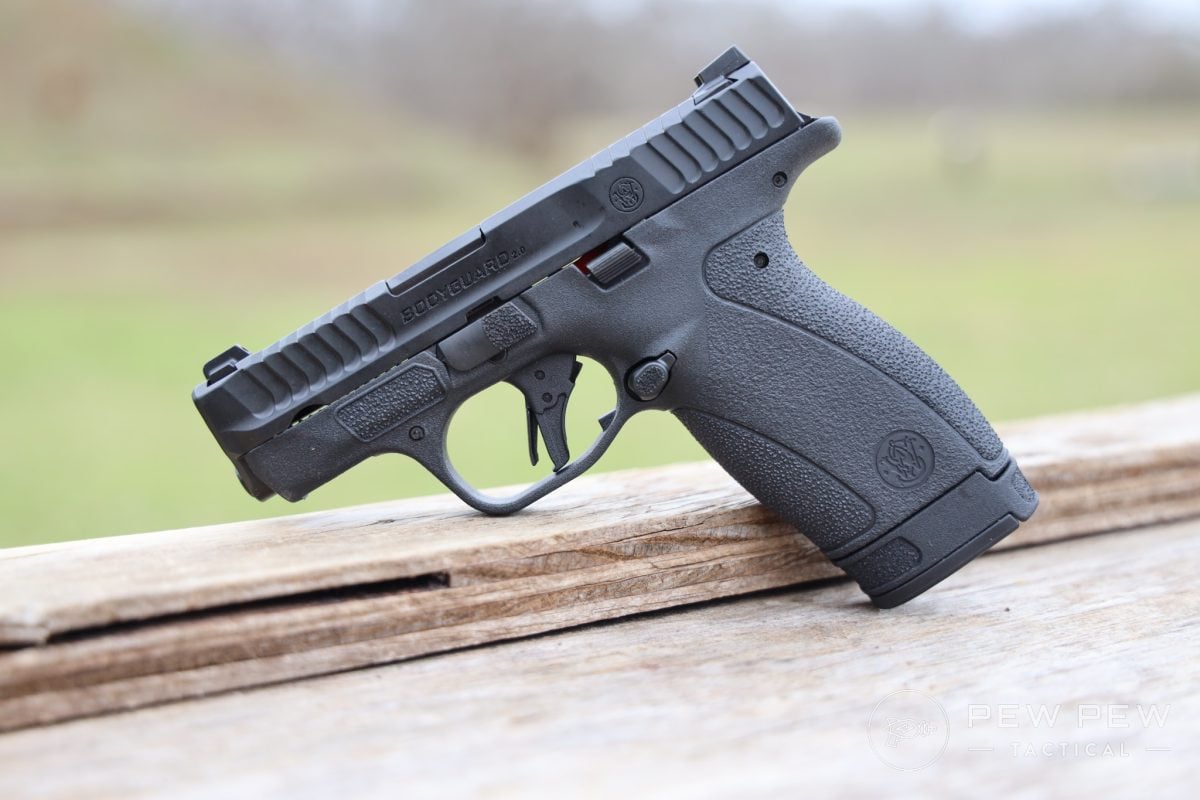
The Bodyguard 2.0 is still chambered in .380 ACP and offers a 12+1 capacity, which is plenty. It’s a good marriage of compact and utility — effective in defensive scenarios while also being super easy to conceal.
With new ergonomics that make it very comfortable to shoot, the improved trigger is a flat-faced design that averaged just over 2 pounds on our digital gauge. Reset was also audible and tactile.
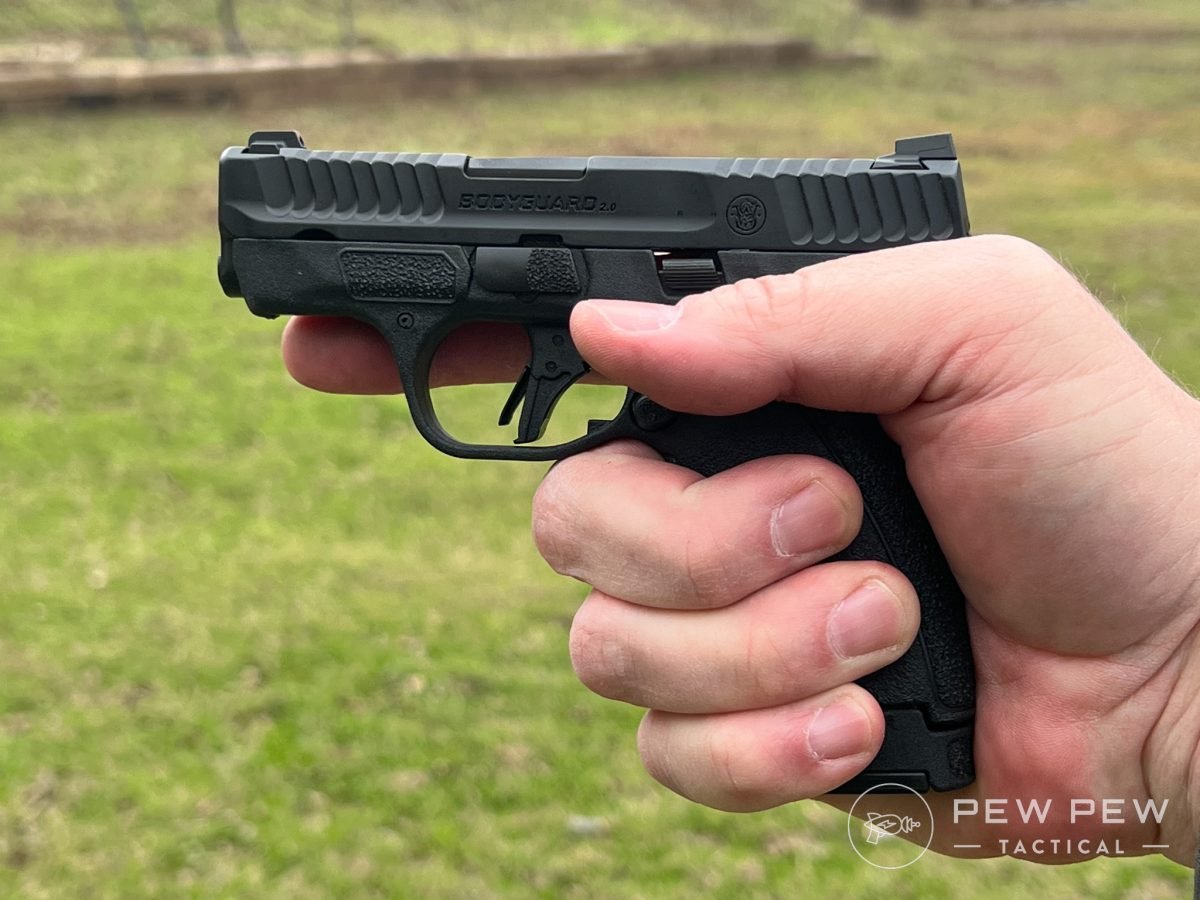
Larger-handed shooters will struggle to fit their mitts around this gun, but if you can deal with a dangling pinkie, you can make do.
Readers rate this a 3 out of 5. What’s your rating? Click on the box to leave a review of your own on Pew Pew Meter.


We dive deeper into the Smith & Wesson Bodyguard 2.0 in our review, so check it out for more details.
5. Kimber K6s – Best Concealed Carry Revolver
Prices accurate at time of writing
Prices accurate at time of writing
-
25% off all OAKLEY products - OAKLEY25
Copied! Visit Merchant
Pros
- Reliable
- Snazzy design
- Smooth trigger
Cons
- Need a speedloader to load efficiently
- Little aftermarket support
- May not work for larger hands
Specs
- Caliber: .357 Mag
- Capacity: 6 rounds
- Barrel Length: 2 inches / 3 inches
- Overall Length: 6.62 inches / 7.62
- Height: 4.46 inches
- Width: 1.39 inches
- Weight: 23 oz / 25 oz
Kimber surprised everyone when they released what is arguably the best gun the company has ever produced — the K6s.
I get it, revolvers are a bit dated, but damn, do I still love them, and damn, do they work. There is something about a finely fitted revolver that exudes elegance but also gives you peace of mind that it will go off when you need it to.
The first time I picked up a K6s, I melted.
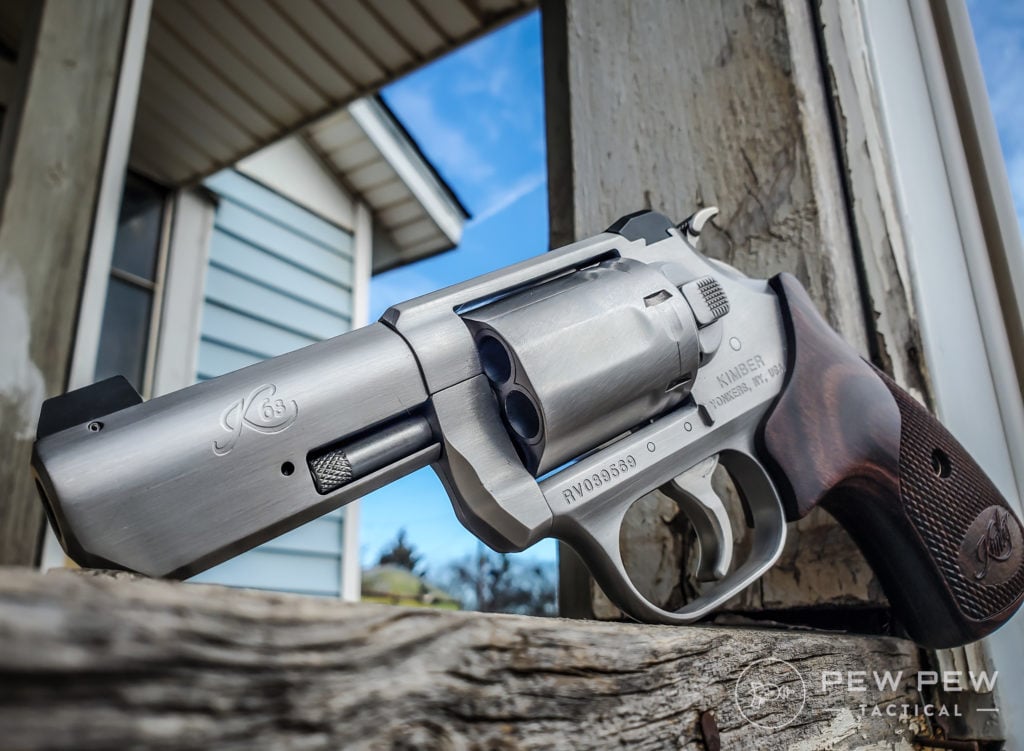
What I held in my hand felt like a combination of old-school Smith and Wesson fitment combined with that sturdy Ruger feeling but with modern styling. It took me a moment to wrap my head around the fact that this is a freaking Kimber product.
Kimber offers the K6s in 2- and 3-inch variants. At 23 ounces, these guns are the lightest 6-shot .357 revolvers on the market, already making them a great candidate for concealed carry.
On top of that, the sights are snag-free and offer an excellent picture, the trigger is great, and the build quality is absolutely top-notch.
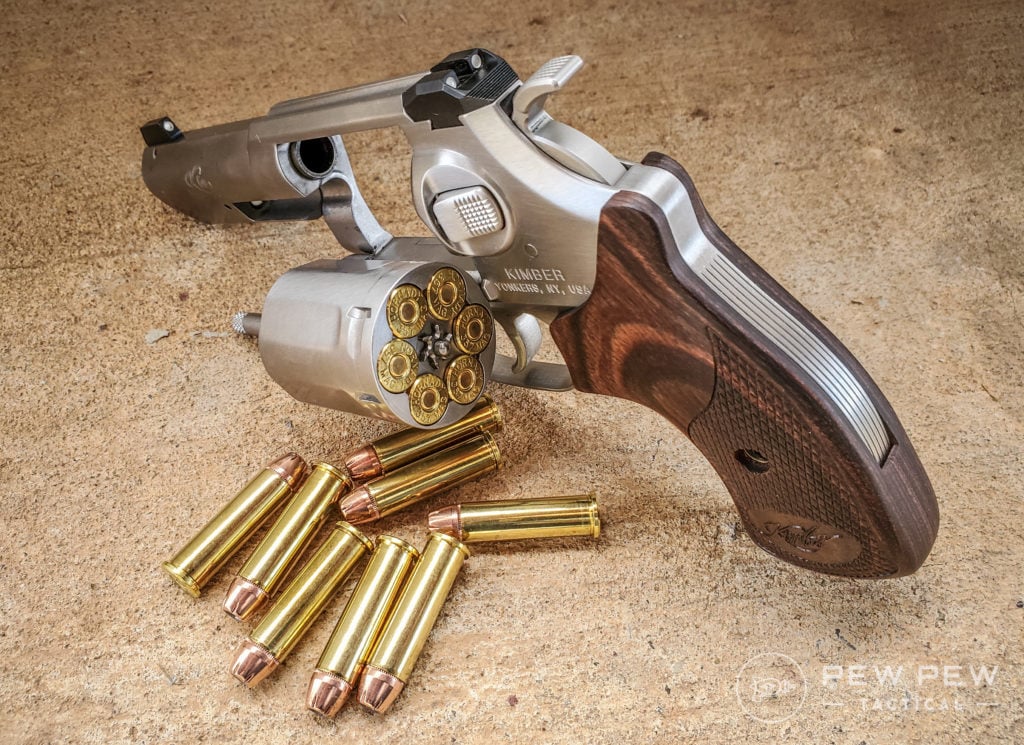
Not only are these guns built well, but they also shoot well and are gorgeous to boot. It may not be the cheapest revolver out there, but its price reflects its quality.


If this one is calling your name, you can read more in our full review of the Kimber K6s (or rate it in Pew Pew Meter.)
6. Staccato CS – Best High-End Concealed Carry Gun
Prices accurate at time of writing
Prices accurate at time of writing
-
25% off all OAKLEY products - OAKLEY25
Copied! Visit Merchant
Pros
- Excellent trigger
- Optics-ready
- Very reliable and accurate
Cons
- Expensive mags
- Pricey
Specs
- Caliber: 9mm
- Capacity: 16+1
- Barrel Length: 3.5 inches
- Overall Length: 7.1 inches
- Height: 5.4 inches
- Width: 1.45 inches
- Weight: 22.07 oz
The Staccato CS is a departure from the rest of the list in that it is the only gun north of $2,000.
So what do you get for all that dough?
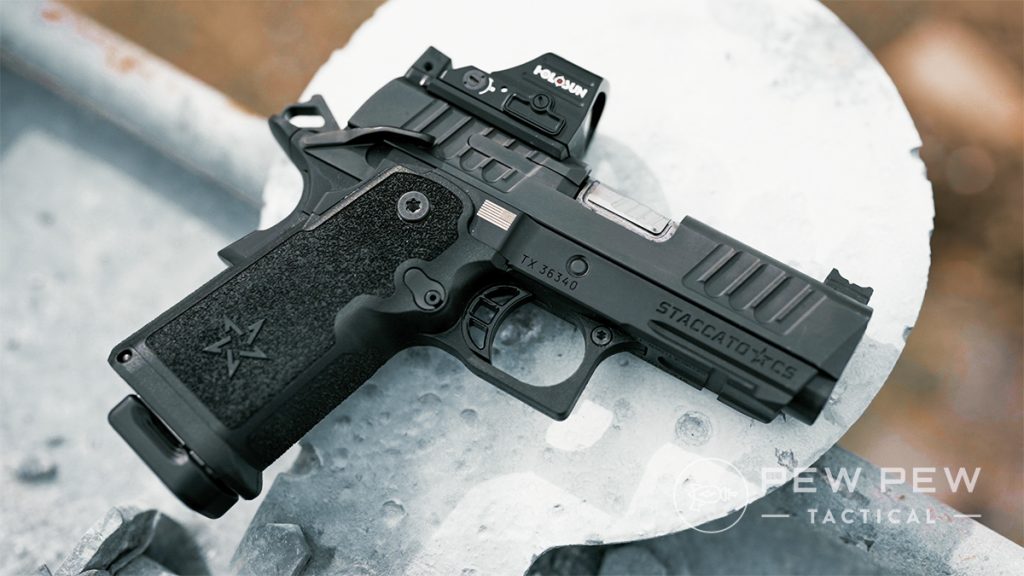
Just a hand-fitted barrel, frame, and slide, precision machined parts, extreme accuracy, an ultra-crisp 4-pound single-action trigger, and arguably the flattest shooting concealed carry gun on the market.
While that might sound like quite a claim, the CS backs it up thanks to years of building experience by the industry-leading 2011 manufacturer Staccato (formerly STI).
I am going to be level here. Is this the best gun on the list? Arguably yes. Is it worth it? Not for everyone.
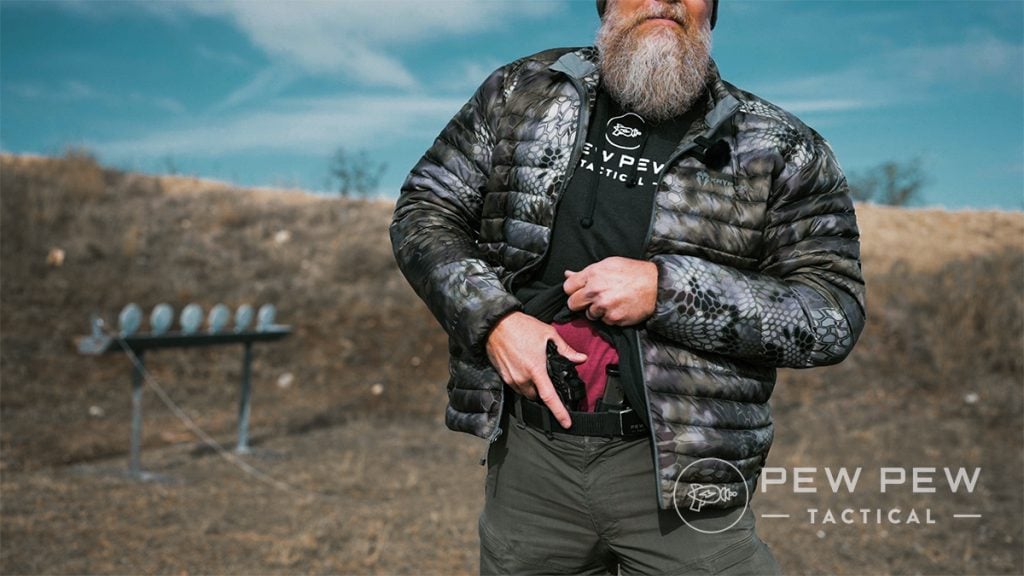
The gun gets high marks for me in most categories, but does fall short when it comes to overall value. Guns like my Cajunized CZ 75 D PCR and Walther PDP compact achieve similar results for much less money.
The CS is a popular choice for those looking for a high-end gun, and it certainly fits that bill. Most of the money is in hand-fitting and the exacting manufacturing process. Our resident content man, Sean, has one that has been reliable as heck and is a smooth operator.
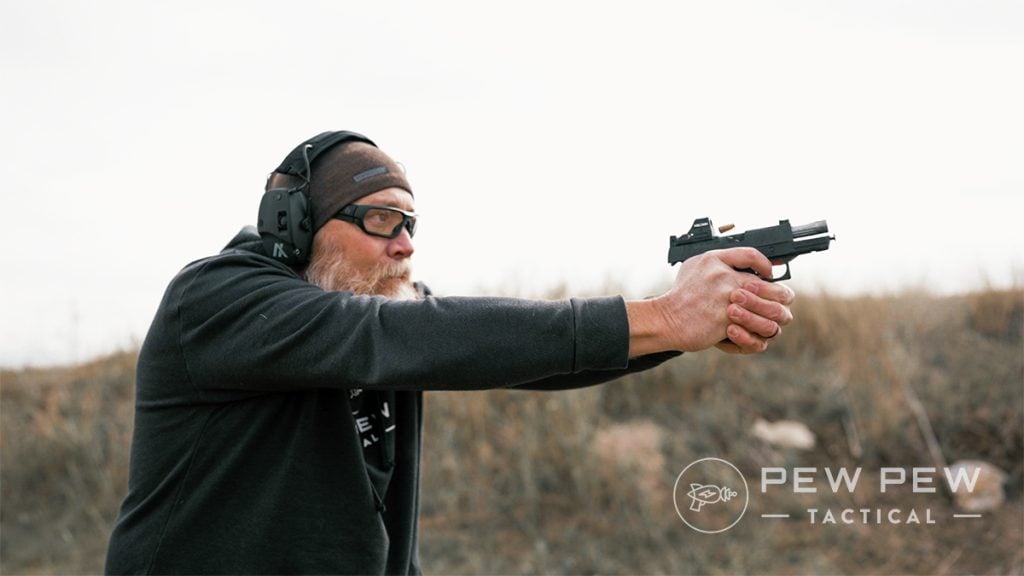
With a 3.5-inch match-grade bull barrel and 16 rounds of 9mm on tap, the CS offers the same capacity as its bigger brother, the C2, but keeps things a bit slimmer and more concealable.
Every Staccato CS is optics-ready, meaning you can squeeze even more accuracy and speed out of an already blazing-fast gun. If you are looking for a pocket sniper rifle, this is the one.


You can read more in our full review of the Staccato CS or check out the video review below.
7. Glock 30 – Best .45 ACP For Concealed Carry
Prices accurate at time of writing
Prices accurate at time of writing
-
25% off all OAKLEY products - OAKLEY25
Copied! Visit Merchant
Pros
- Reliable
- Large aftermarket
Cons
- Shorter grip might be tough for larger hands
Specs
- Caliber: .45 ACP
- Capacity: 10+1 / 13+1
- Barrel Length: 3.78 inches
- Overall Length: 6.97 inches
- Height: 4.80 inches
- Width: 1.38 inches
- Weight: 26.28 oz
Although it may be associated with older guns and the older crowd, .45 ACP is far from dead.
Shooters who enjoy this caliber will want to take a look at the Glock 30.
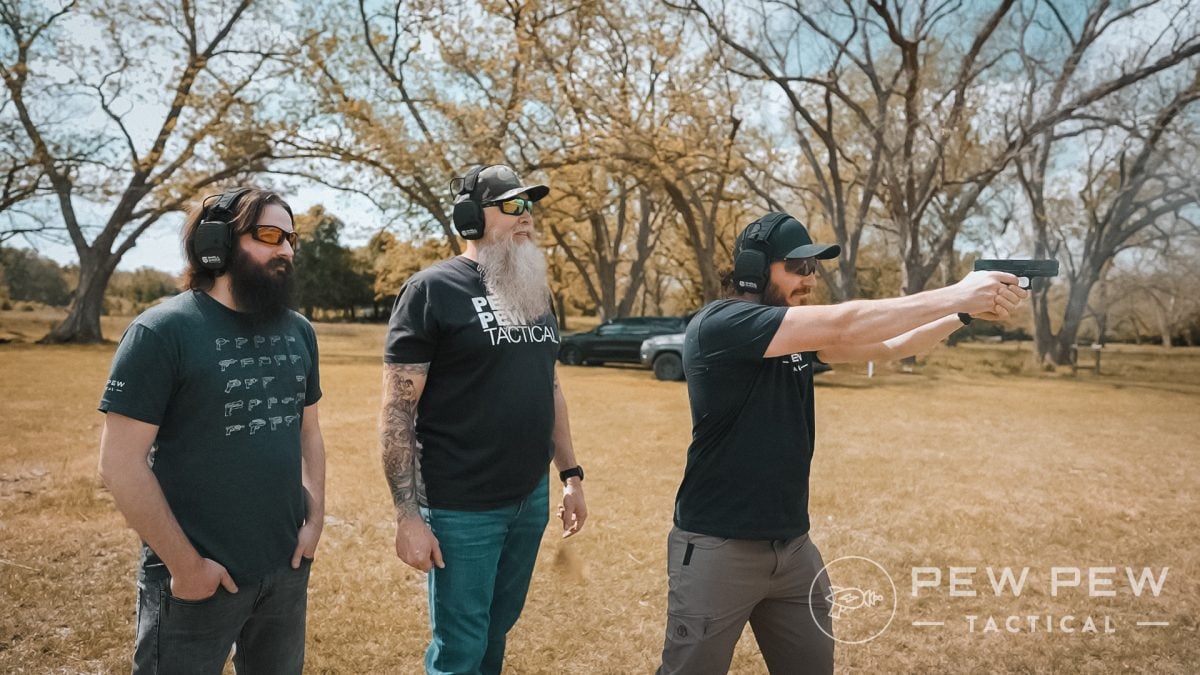
A slightly smaller version of the Glock 21, this model is concealable while still packing the .45 ACP heat you’d want. It holds 10+1 rounds in a standard mag, or you can use a Glock 21 mag that will give you 13+1.
Like all Glocks, it’s sturdy, reliable, and sports the all-too-familiar Glock blocky build. It features adjustable backstraps to work with most hand sizes, aggressive texturings on the grip, and a mag release that is easy to engage.
Downsides? The grip is a little short, so those with bigger hands will struggle to get a full firing grip.


You can read more about the Glock 30 and other .45 ACP Glocks in our Best .45 ACP Glock article!
8. Canik TP9 Elite SC – Best Budget Concealed Carry Gun
Prices accurate at time of writing
Prices accurate at time of writing
-
25% off all OAKLEY products - OAKLEY25
Copied! Visit Merchant
Pros
- Excellent trigger
- Great value with included accessories
- Optics-ready
Cons
- Wider than most micro-compacts
- Higher bore axis
Specs
- Caliber: 9mm
- Capacity: 12+1 or 15+1 rounds
- Barrel Length: 3.6 inches
- Overall Length: 6.7 inches
- Height: 4.6 inches
- Width: 1.45 inches
- Weight: 24.8 oz
While micro-compacts currently rule the roost, not everyone fancies an ultra-thin gun. Alternatively, some people still want something shorter than the standard 4-inch compact barrel.
Whether it is hand size, comfort, or control, there is still a solid argument for the good ole’ basic sub-compact handgun — especially one as good as the Canik TP9 Elite SC.
I own various sub-compacts, and in addition to typically having mag compatibility with their full-size brethren, I find them to just feel a little more “substantial” than micro-compacts, so to speak.
Canik has come on strong in the last few years with the TP9 lineup, which are Walther-derived guns. The Elite SC is no exception and features Canik’s famously good triggers, great accuracy, and reliability.
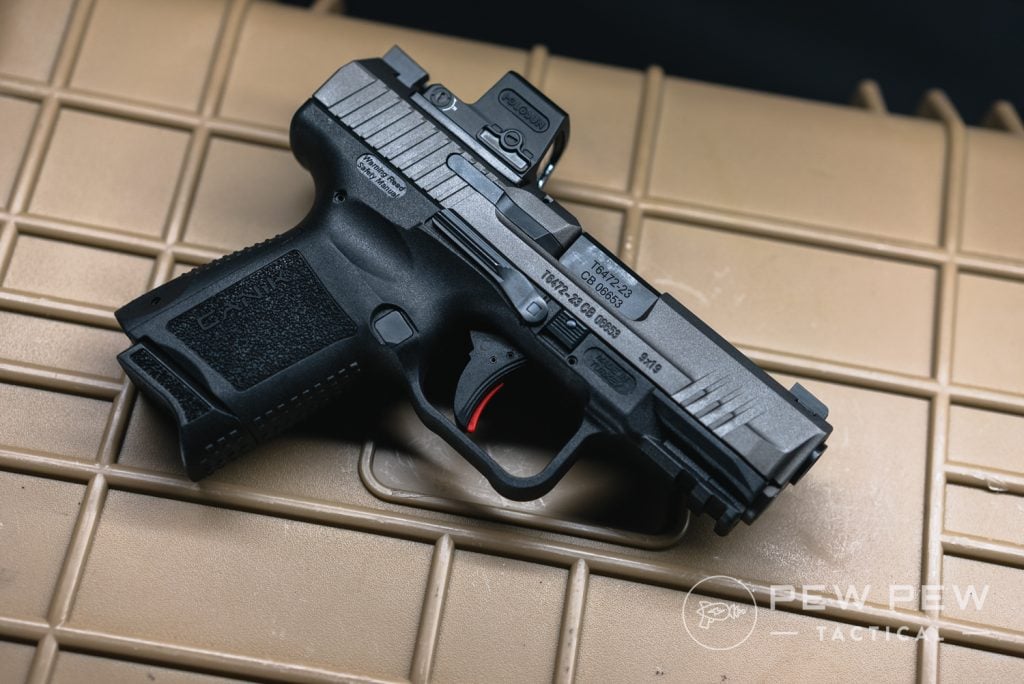
With the Walther PPQ SC being among the best shooting sub-compacts I have ever handled, it is no wonder the suspiciously similar Elite SC is right on par with it, if not better.
The TP9 Elite SC features a 3.5-inch match-grade barrel, blacked-out rear, and phosphorous front sight, ambidextrous slide release, and an optics-ready slide cut for Shield RMS/RMSc pattern dots.
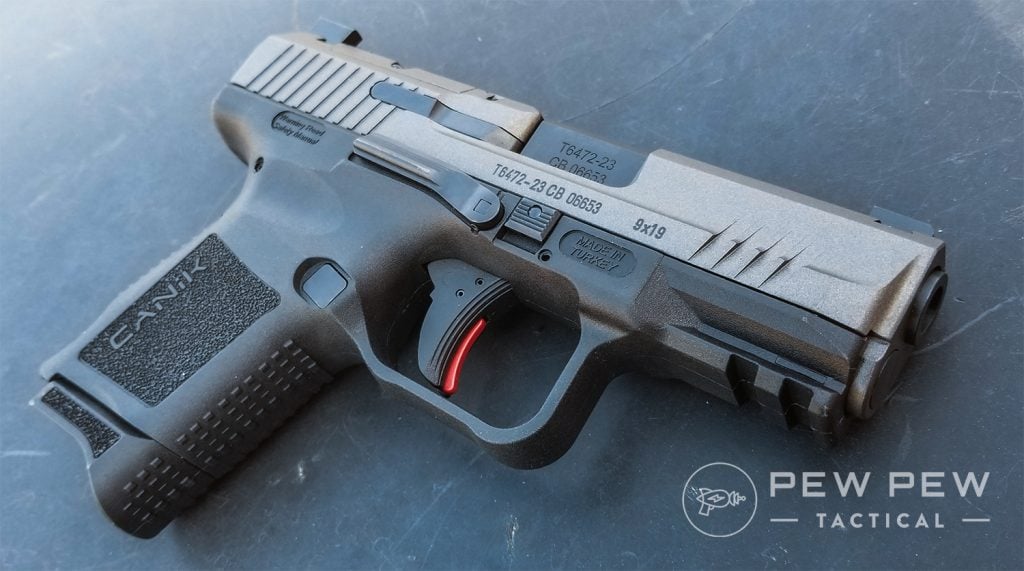
Standard flush fits magazines offer you 12 rounds on tap, with extended 15-round magazines also available.
If you want something short and easy to conceal but isn’t overly thin, the Elite SC might be for you. Oh, and it is easy on the wallet, too!


You can read more about why I love this gun in our full review!
Honorable Mentions
These are for the guns we feel need a quick shoutout, but just missed being on our main list.
9. Ruger LCP Max
Prices accurate at time of writing
Prices accurate at time of writing
-
25% off all OAKLEY products - OAKLEY25
Copied! Visit Merchant
Pros
- Super lightweight
- Good value
- Decent sights
Cons
- Not great with steel-cased ammo
- Requires tool to field strip
- Snappy
Specs
- Caliber: .380 ACP
- Capacity: 10+1 rounds
- Barrel Length: 2.58 inches
- Overall Length: 5.2 inches
- Height: 4.12 inches
- Width: 0.81 inches
- Weight: 10.6 oz
Sometimes, when you are concealed-carrying, you want to ensure your gun is concealed. That is where the Ruger LCP Max comes in.
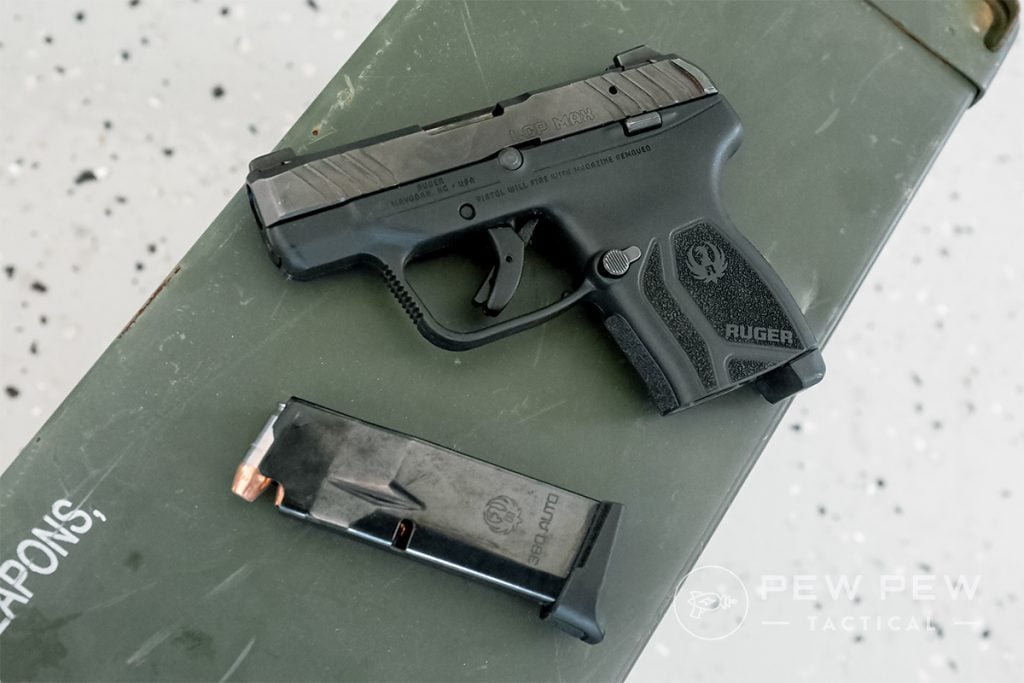
Even in today’s world of tactical this or extreme that, I feel that tiny carry pistols still have a large (pun intended) role to play.
Sometimes I want to carry a full-size duty gun, and sometimes I just want something small enough to tuck away or shove into my pocket, and the LCP fits that bill to a tee for me.
Pew Pew Tactical founder Eric Hung describes it as “the ultimate combination of weight, size, and capacity for a .380 concealed carry gun.”
The LCP Max comes in under an inch thick and is only 10.6 ounces. It is 5.17 inches long, 4.12 inches tall, and has a capacity of 10 or 12 rounds (extended).
With those stats, we agree with Eric.
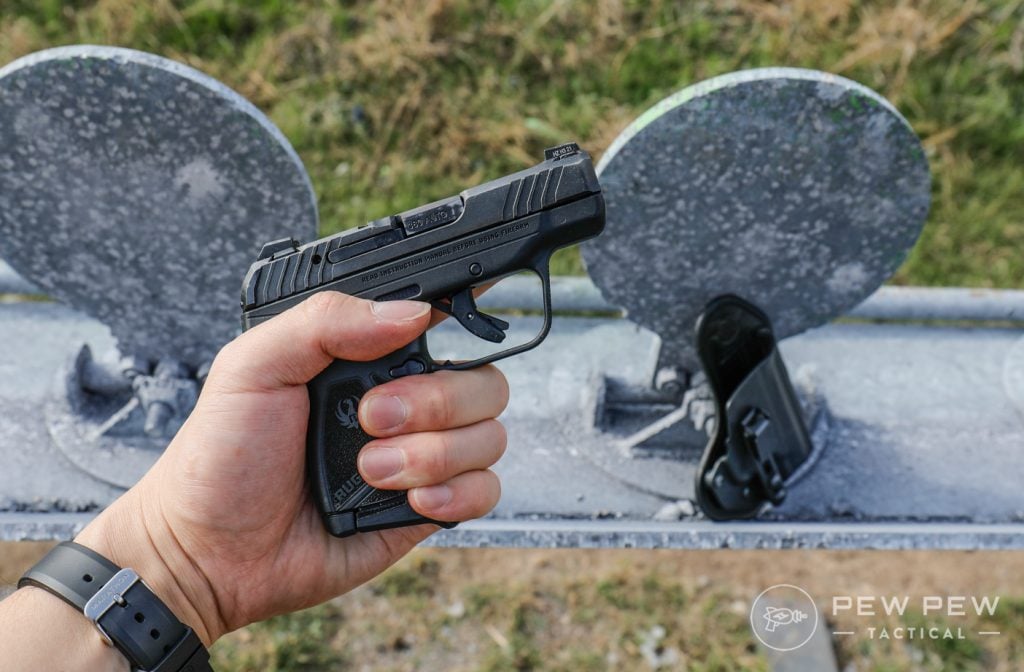
A set of solid sights helps achieve surprising levels of accuracy for a gun of its size, and the gun’s popularity means holsters are plentiful.
Take a peek at Eric’s hands-on review of the LCP Max or write your own review on Pew Pew Meter!


10. Glock 19
Prices accurate at time of writing
Prices accurate at time of writing
-
25% off all OAKLEY products - OAKLEY25
Copied! Visit Merchant
Pros
- Tons of aftermarket support
- Proven reliabilty
- Easy to use
Cons
- Plastic sights
- Mediocre trigger
- Blocky ergonomics
Specs
- Caliber: 9mm
- Capacity: 15+1
- Barrel Length: 4in
- Overall Length: 7.36 inches
- Height: 5.06 inches
- Width: 1.26 inches
- Weight: 21.16 oz
While we don’t think the Glock warrants a spot on the main list, we do feel like it’s worth mentioning since it’s a common entry point for many beginners. The Glock 19 itself is a good starting point — a nice mid-size option for those who want a nice shooting Glock that is still concealable.
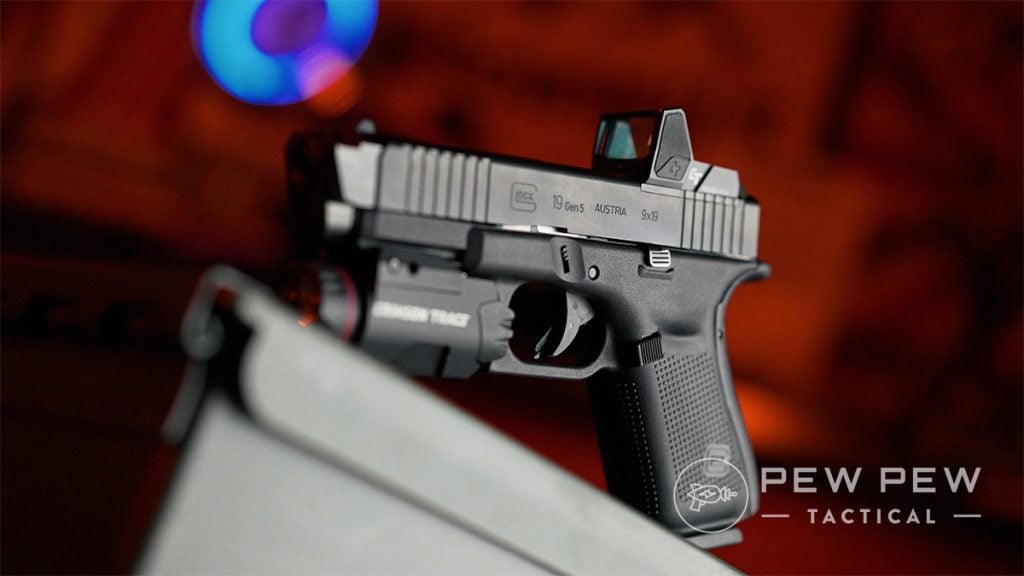
What the Glock 19 has going for it is reliability. These guns just don’t quit, which makes them an attractive option for many concealed carriers. The aftermarket is also a selling point for Glock pistols, specifically the Glock 19.
Hate those plastic sights? Replace them. Don’t like the trigger? Swap it out. Need a holster or 10? Literally every holster maker has a Glock 19 holster.
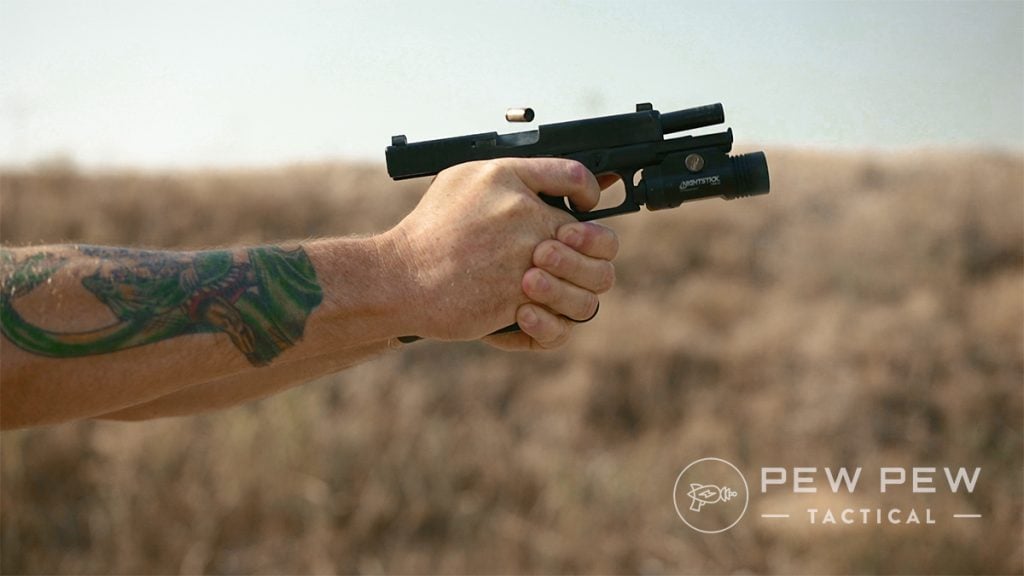
Where the Glock loses points is in the block ergonomics that don’t really feel great. Smaller-handed shooters will struggle to fully reach the trigger, which can cause shots to be thrown left or right as you twist your wrist to reach.
We also don’t love that after all these years and models, Glock still defaults to cheap, plastic sights and a mediocre trigger. At this point, give the people what they want, and let’s make these better.
But if you can deal with the ergos and lack of features, the Glock 19 is a decent option to start.
We have a full review of the Glock 19 (3,500 rounds + and still going) if you need more info, or you can check out what others have to say over at Pew Pew Meter.


Best Concealed Carry Gun Upgrades
Best Gun Belt – Kore Essentials
You’ll need something firm but doesn’t scream, “I’m carrying a gun.” We have a couple of our favorites here in our Best Gun Belts article.
Prices accurate at time of writing
Prices accurate at time of writing
-
25% off all OAKLEY products - OAKLEY25
Copied! Visit Merchant
But our favorite is the Kore Essentials X7 which ticks all the boxes.
Best Holster – Concealed Carry Holster
You’ll also need a concealed carry holster that safely covers your trigger, feels comfortable, and allows for a quick draw.
See all our favorites at Best Concealed Carry Holsters since there are a bunch of different styles and carry types.
Prices accurate at time of writing
Prices accurate at time of writing
-
25% off all OAKLEY products - OAKLEY25
Copied! Visit Merchant
However, our favorite is Hidden Hybrid Holsters for their super comfy leather backer and rigid Kydex shell.
FAQs
What is the best caliber for concealed carry?
The best caliber for CCW is the one that you feel most comfortable using -- whether that's .380 ACP or .45 ACP, it's a matter of what you feel confident shooting.
What features should I look for in a concealed carry handgun?
When shopping for a CCW pistol, look for things like size, shootability, reliabilty, features (red dot ready, external safety, etc), and of course what fits within your budget.
How do I chose the best concealed carry gun for me?
While we have some great recommendations above, we highly suggest you head to a local range that offers rentals and try some out. The best way to find the one you like is to shoot a few.
Is concealed carry allowed in every state?
Concealed carry laws vary by state, so be sure to research what your state allows in specific.
Meet the Experts
Leading the write-up for this article is Wyatt Sloan, Pew Pew Tactical Jr. Editor. Wyatt is an NRA and USCCA certified instructor with previous experience as a USPSA competitor and as a home-based FFL. He personally owns over 200 firearms and concealed carries. Wyatt uses his extensive experience with firearms to test handguns like concealed carry pistols for Pew Pew Tactical.
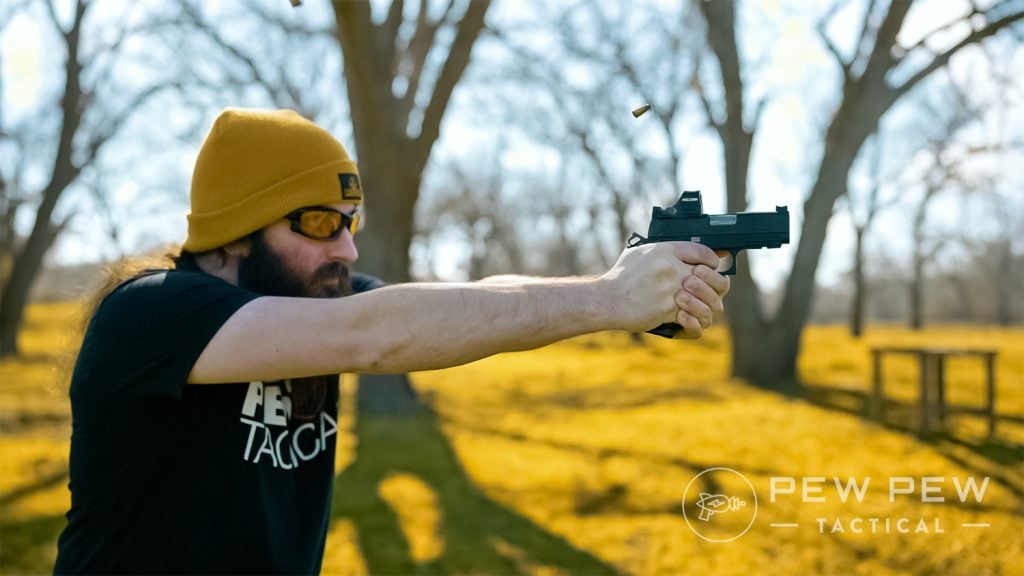
Editor-in-Chief Jacki Billings edited and added to this article. She runs our experienced team of gun reviewers. Jacki is a member of the Society of Professional Journalists, ACES: Society for Editing, and the Professional Outdoor Media Association. Jacki has a bachelor’s degree in Mass Communications and has worked as a media professional for close to 20 years, specializing in gun media for almost 10 years. She uses her extensive professional journalism and editing experience to set testing protocols and editorial standards.
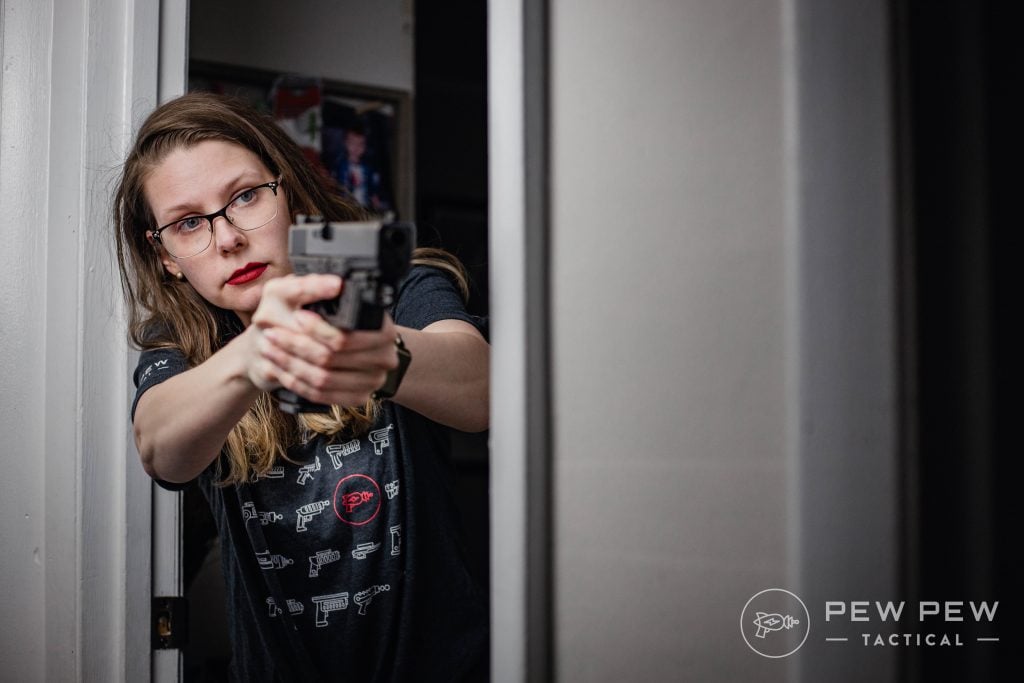
Final Thoughts
Covering all the great concealed carry guns out there would take ages; thus, sacrifices had to be made (including some of my personal favorites).
This list is meant to cover some of the best and easily available carry guns that work well for a majority of shooters.
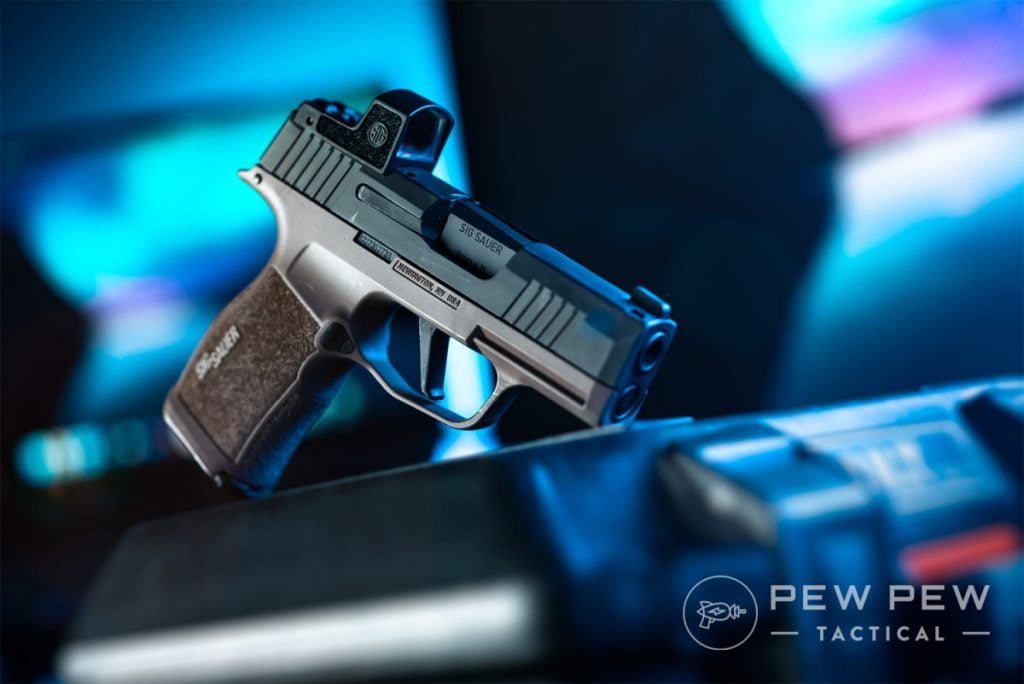
If your gun didn’t make the list, don’t fret, and remember, the best concealed carry gun is the one that works for you.
What are your thoughts on these guns? Let us know in the comments below! Still, considering more options? Check out our articles on the 8 Best Compact 9mm handguns and Best Micro Compact 9mm Handguns.
Latest Updates
- June 2025: Added the Smith & Wesson Bodyguard 2.0, Staccato C, and Glock 19. Moved Ruger LCP Max to Honorable Mentions. Removed the Staccato CS and Springfield Armory XD-M OSP .45 ACP.
- October 2024: Replaced Staccato C2 with Staccato CS.

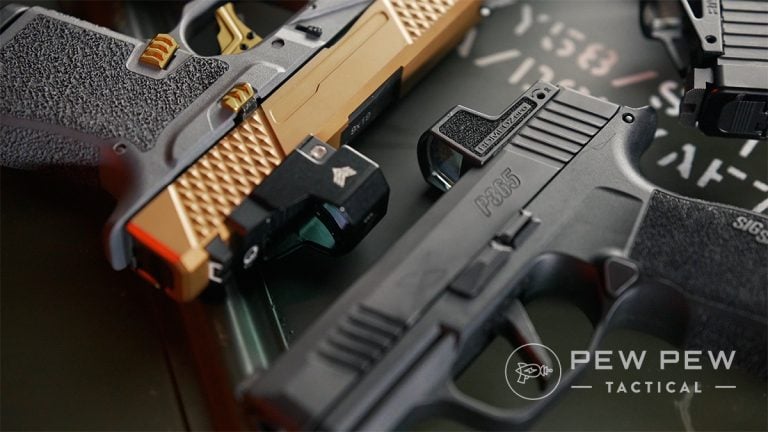

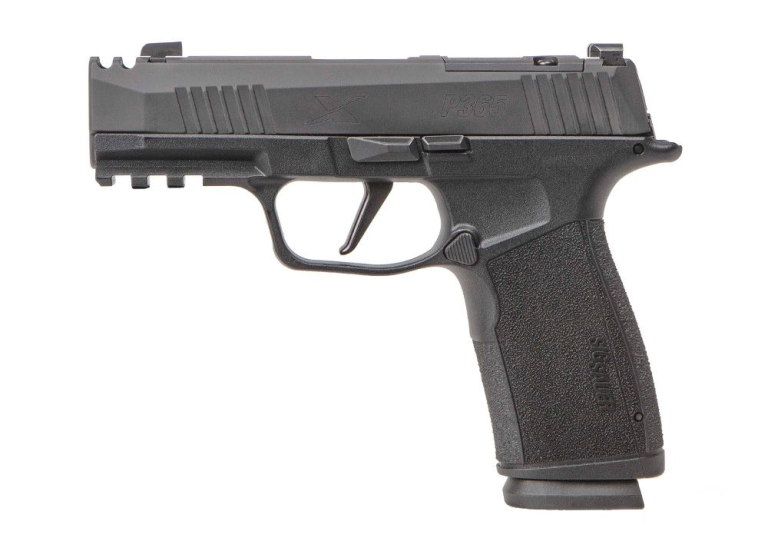

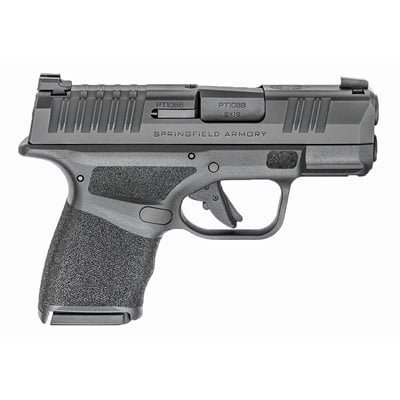

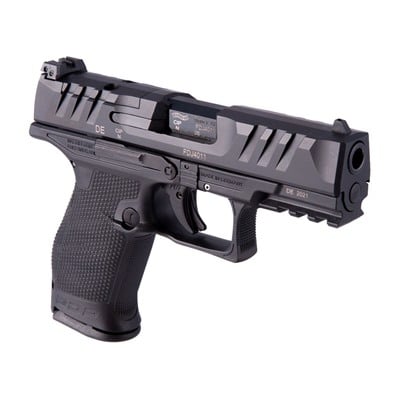

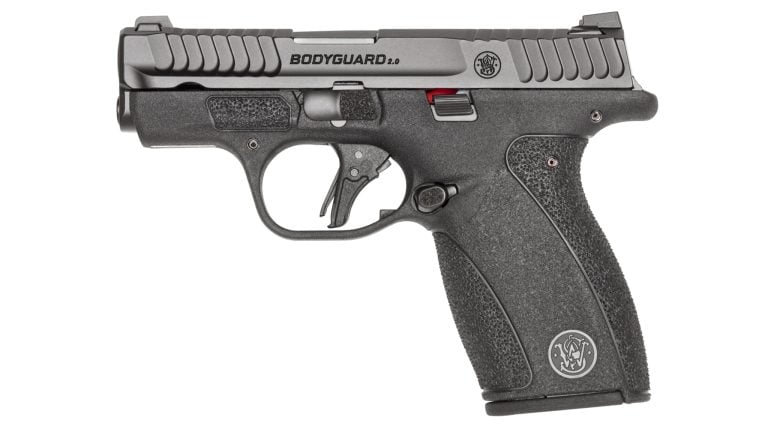
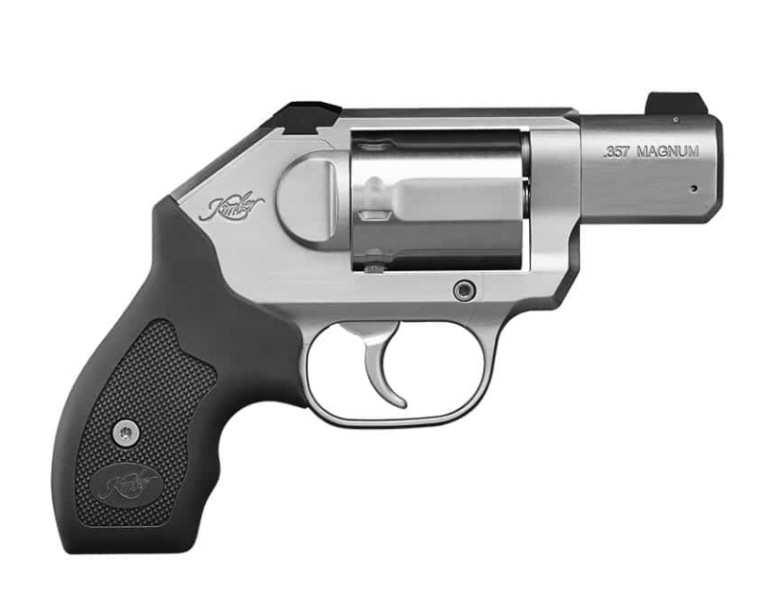
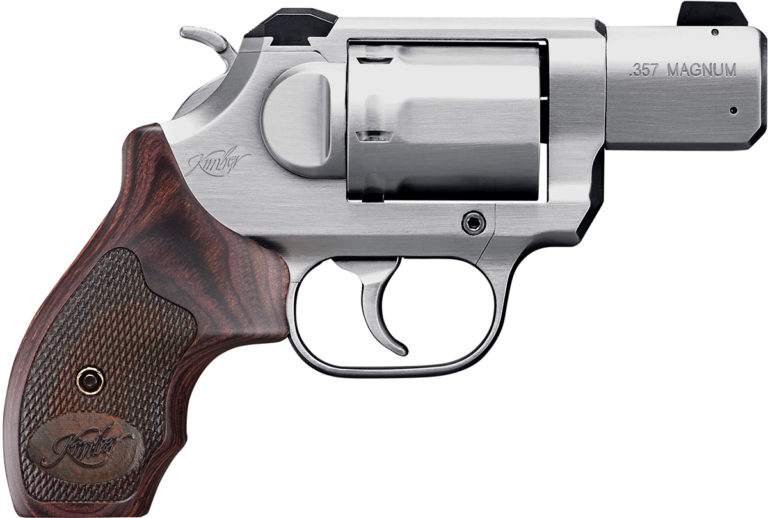
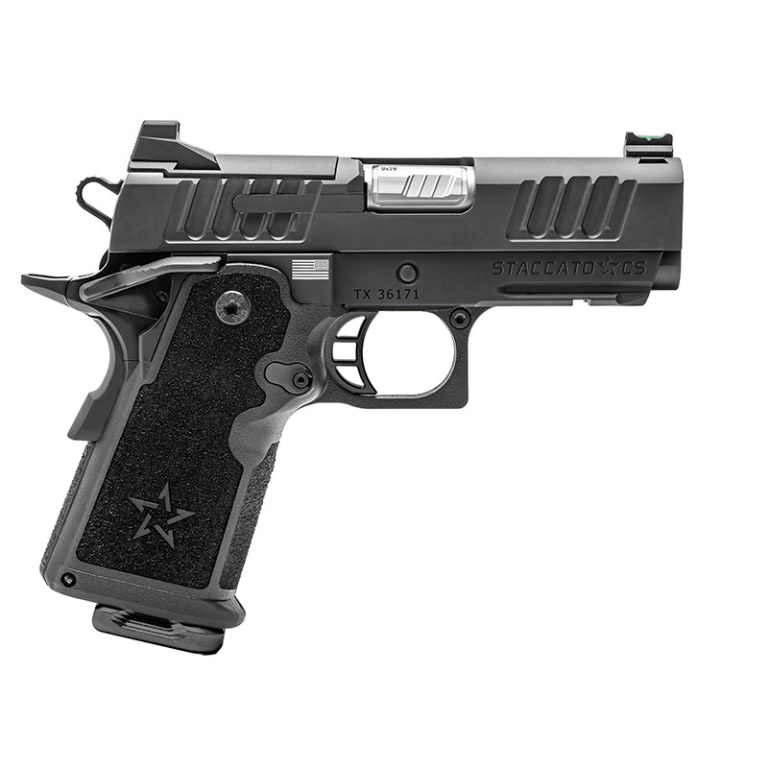

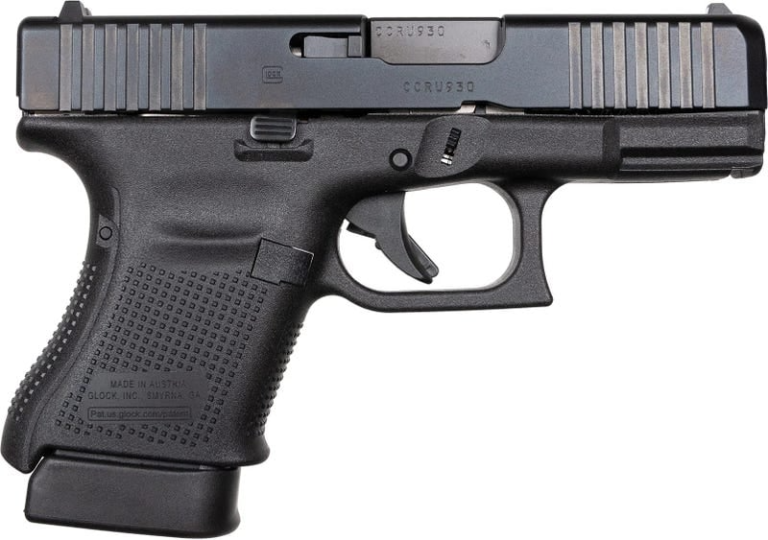


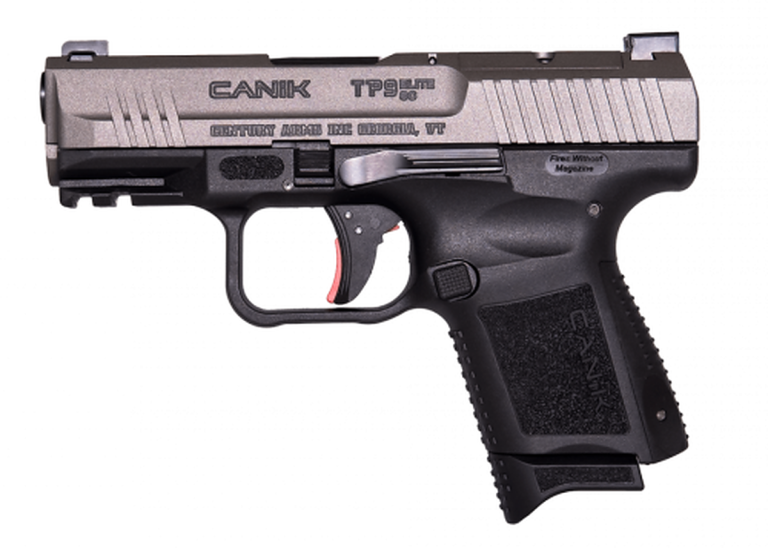

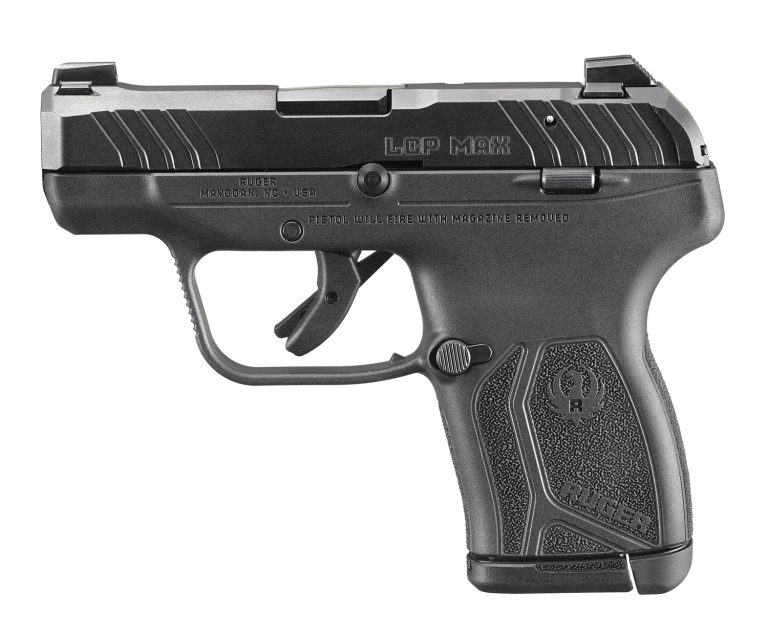

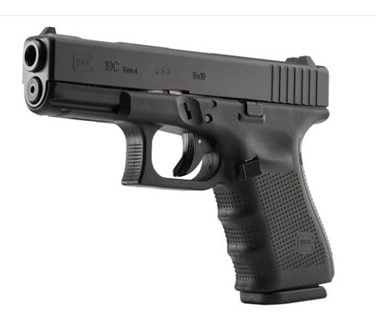









376 Leave a Reply
I trained at Jeff Cooper's Gunsite in 1977 and qualified Expert with a 1911 .45ACP (still use it). But over the years the bad guy number began creeping up, so I bought a G19 Gen 5 the year it came out. My mods: 1) Tritium front sight; 2) replaced rear sight with plain black, because Nobody needs their eyes drawn to the rear sight - ever!; 3) Pearce grip backstrap plug. This is my daily carry gun and it has never failed, and I shoot a lot. I also highly recommend the DryFireMag for dry fire practice. Dry fire is the most effective way to learn real trigger control, when you have good training behind you.
My wife and I have the original 6 round S&W Bodyguard because we are both small stature. I wanted a firearm I could pocket carry that has a manual safety. Many complain about the safety which I believe why S&W went with a trigger safety on the 2.0 model. I took the pistols apart and rounded off the triangle safety that slides across the spring. They are much easier to disengage and engage and I don't have to worry about fumbling around in my pocket in an emergency situation and accidentally shooting myself with a trigger safety.
While I appreciate the constant updating of the these type lists: "Best Concealed Carry," "Best Duty Gun," "Best Range Pistol," etc., etc., etc., I feel like theses lists are the same thing over and over with the same firearms. I would love to see lists of firearms in a category that have not been reviewed. There are tons of pistols, shotguns, and rifles out there. And you don't have to even like them. An honest review of a gun that isn't on one of your lists is a good thing. We all know that the Hellcat, P365, and M&P guns are pretty good and likely what people want to buy. But What about the IWI Masada Slim Elite? Or others that don't make it on any of your lists. That's just an example. Doesn't even have to be a full range review. Just some exposure so people know what they might be getting into. Love the site though and you all do good work.
I totally get the frustration, Don. Same pistols recommended over and over can get boring, for sure. This one is geared more towards beginners who are looking for easy to use guns that are pretty accessible. That said, that's why we created a list called the Most Underrated Concealed Pistols which have suggestions that aren't the typical P365. Check it out and see if you like that one a bit better: https://www.pewpewtactical.com/most-underrated-concealed-carry-guns/
An interesting choice might be the Browning 1911-380 Compact. Very thin, petite even, easily concealed. two draw backs though, only 8 rounds in the magazine and becoming hard to get. If you like 1911's and want something more concealable it might be worth your taking a look.
Thanks for the suggestion, John!
My LCP provides a great deal of security for me and my wife. It is just not a combat pistol or a long range shooter. It is an extension beyond the punch/kick/knife/stick. At 10 or 15 feet it is deadly. Further than that and it is still likely to tag the bad guy. A lot further and I'm gonna run.
LCP is solid for sure!
The P365 X-Macro listed/displayed has a 3.7" barrel, not 3.1" it's the X-Macro "Comp" that has a 3.1" barrel.
Oops. Thanks for catching that!
I am missing two guns on this list that I feel are better than some of the obvious many times used before pics. The Kimber carbon compact is a very good gun. And the Ruger RxM is an excellent still concealable option. Trigger not as good as the PDP but equals or betters it in other fields. No need for optic plates and it is modular. But that is my personal opinion.
Hey Ramon! Excellent suggestions. We've had time with both and have a review of the RxM. It's tough with these lists because we can't list everything we like or it would be near endless. Lol.
When I saw the first award, "Best Overall," was awarded to Sig, I knew they weren't putting Glocks on the list lol
My carry is the S&W Bodyguard 2.0 and it is perfect. Shoots well, no faults when shooting a lot of rounds through it (I keep it clean) and comfortable for all day carry. Small enough to be well hidden, and the .380 Inceptor rounds are perfect for self defense.
WOW. I know you have just been waiting to hear this. Not one single Glock? The fact that you have a Ruger on here with the "Con" of "Hates steel-cased ammo and required a break-in of 200 rounds" is funny in itself. You will never experience that with the Glock 43/43X. Appreciate your reviews, ratings, and knowledge you share but this was just too much for me to take.
My P365 had a defective trigger reset spring and was therefore unreliable. I immediately went to the Smith and Wesson M&P Shield Plus and I have had zero issues! Love the Walther PDPs. The full size with a green dot is a game changer for speed and accuracy.
I’ve not tried the Smith & Wesson Bodyguard 2 yet but from everything I’ve heard it is superior too the LCP max so I’m surprised it wasn’t in here as well
Excellent article, and for me depending where I am going and how I am dressed my edc rotation has a lcp max w/12 rd mag, hellcat w/13 rd mag, and glock 27 w/13 rd mag
Amen! LtCol Cooper is rolling over in his grave.
You missed the S&W Bodyguard 2.0
Girsan MC P-35 PI LW Ops:
4.88 length barrel, sculpted beavertail, undercut trigger guard, beveled magazine well, extended low-profile ambitious safety and slide release, light rail, direct-mount optic, fiber optic front sight, flat trigger
no magazine disconnect safety, chromed barrel with a reverse crown, G-10 grips, 15 + 1 Capacity - 9mm all for $505.00. Stacks up to the Walther PDP Compact and after all it's a Hi Power!
just remember if you have to use your concealed carry pistol in a self-defense scenario you are going to lose it whether temporarily or permanently, so choose wisely, which would you rather have sitting in law enforcement evidence lock up? $2k-$4k boutique pistol or a $400 semi disposable.
I know hammer fired is a dirty word, but my Girsan MC P-35 PI LW Ops:
4.88 length barrel, sculpted beavertail, undercut trigger guard, beveled magazine well, extended low-profile ambitious safety and slide release, light rail, direct-mount optic, fiber optic front sight, flat trigger
no magazine disconnect safety, chromed barrel with a reverse crown, G-10 grips, 15 + 1 Capacity - 9mm all for $505.00. Stacks up to the Walther PDP Compact and after all it's a Hi Power!
Your forgot the HK VP9SK!
No 10mm ? ! ? At least you got the p365 right but my big ass hands need the macro-tacops
I go with the P30SKS. I’ve become an HK snob and am proud of it!
S&W Bodyguard 2.0????
Asking for a friend.
Can we see a list of the best concealed carry .45 1911’s? Most of the lists nowadays just have 9mm’s.
My preference is the springfield xd 3"
I recently stumbled on this website "switchgunshop.shop" They've got the switch-gun made by Standard Manufacturing which is the best Conceal Carry Gun currently on the market at the right prices - at least that was the case with me! Check em out.
No CZ P01? Hmmm....
Old gun, but a proven, yes a proven pistol. HK P2000 v2 9mm. Good size, ergonomically sound, and extremely reliable. Red dots not really necessary at close quarters combat, under five yards or less.
Why did you leave out the S&W MP's. I've shot 3 out of your favorite list. And my M&P full size outshot all three!!!!
For mainly home defense with maybe an occasional conceal and carry Walther PDP compact or Sig P365XL? Thanks for your thoughts.
I should have added I will try them both at a local range before purchase along with a Glock 19 and M&P Shield Plus.
My p365 sig is great but I keep going back to my G43X with Shield mag for 15 +1 with no extension.
Ditto on the G43X
Where is the XDS45? One of the best subcompact 45's out there.
No love for S&W huh?
Hell I carry a Beretta Tom Cat in my front pocket as it’s hot and humid here.
None of those guns mentioned are available in the area where I work so we make do with what we have. Baby Glocks are popular too.
A little surprised the Hellcat was chosen over the S&W M&P 45. The Hellcat is a fine gun but except for 1 round less capacity the S&W 45 performs just as well, I believe is a bit thinner & at least $200 less than the Hellcat.
For a budget but reliable gun, consider the SCCY DVG-1.
Thanks for the “promotional” article. I hope you enjoy your commissions.
I’ll stick with my Beretta PX4 compact.
I was about to apply for a job at your place, but, nahhh… I might even just cancel the whole email notifications and whatever…
There’s one guy I like from your videos…
I’ll try to follow him elsewhere…
Gregory in Tejas
I am new to the gun world and armed self defense. Can you point me to any other sites that provide this type of information? I am primarily interested in concealed carry, comparable guns and holsters, and a complete breakdown comparison of insurance in case I need to actually shoot someone in defense of myself or my family. Appreciate any information, just started less than a year ago, a total beginner. Thank you, especially if your site is free since I am retired on a fixed income.
I carry either my J body S&W Airweight 38 + P while riding motorcycles or my G43 for everything else.
The right answer is a Glock 43, everything else is less reliable. Agree with the Walther and would rate it higher then you did. In general, the Sig is a piece of trash.
Can’t argue with the reliability of Glock. The 26 and 43 (as well as 43X and 48) are definitely great choices, and should be on any list for concealed carry. I’m a fan of thumb safeties for my CCW, so I prefer makes / models that have that option. I understand and respect differences in opinion regarding this. Lots of great choices out there.
Dang. I usually enjoy these articles. While I don't always agree with every choice the staff makes in every category, this is the first one of these that I truly feel that you missed the boats. Every. Single. One.
I thought about this long and hard, but I can't make myself change my mind. However, I am looking forward to the next installment.
To repeat your comment,
Every.
Single.
One.
This article/(opinion) was a joke.
Surprised that the S&W Shield Plus didn’t make the list. It is as good as (and better than IMHO) the Hellcat. Nothing against Sig or Springfield, but I prefer the Shield. Just as reliable, and probably a bit less expensive than some of the others.
I second your well-educated opinion.
No p10m? ...too boring and generic guess...
How is it there is no CZ or S&W on this list is nuts....
I carry a Shield. Great pistol for the price and dead reliable. Not a rich man by far.
God forbid something happens - the PD will take your EDC on the spot.
Let them take a $400 pistol rather than a $2200 one. IMHO
Well, I am certain I will not be the only one to point out a glaring omission in the list! But first, I own the P365, with modifications, and truly consider it the best concealed carry option out there. As for the Hellcat, I think the ONLY reason it sells is because buyers fail to shoot other guns first. The grip is small, it is SUPER snappy, almost to a fault, and the aftermarket is virtually non-existent. The Ruger LCP is just a KelTec P3AT copy, and if KelTec was smart enough to discontinue it, so should Ruger! In fact, I cannot believe KelTec did not enforce patent infringement against Ruger for this blatant copy.
Oh, and regarding the obvious omission: The Glock model XXX (insert 43, 46, 48, 19, 45, or other) CERTAINLY is a better choice than many models listed based on cost, reliability, capacity (especially with Shield mags), and unrivaled aftermarket support, and ease of cleaning/upgrading.
I am fairly certain this omission was a calculated chance for the author to be provocative and to elicit comments like mine. You win!
I agree with you about the Glocks being omitted from this list. I own the Sig P365XL and a Ruger LCP, but the Glock 43X MOS with Holosun 507K optic is what I carry every day unless it’s real warm and I got to a pocket pistol and then it’s the Glock 43 with Crimson Trace. I must say the Ruger is cheapest and smallest, but it’s “snappy”.
That Kimber K6 looks sweet
I love my GX4XL
Had a Canik Elite SC and sure, the gun has a great trigger, decent sights, good ergonomics and fit and finish. Trouble is it’s unreliable. I got rid of mine as soon as it started dropping the striker without discharging a round when riding that beautiful trigger. There was no dimple on the primer and I only used brass cased, new factory 124gr ammo.
My full size METE is better, but I think it happened to it once or twice too. I’ll keep the METE since my wife likes to plink with for now, but I’ll never buy another Canik again.
The customer service is responsive, but they don’t test fire. So they cannot replicate the issue nor can they test to see if it was remedied after whatever repairs are performed.
Moral of the story is stick to proven designs/brands. I was always partial to Glocks (I currently own a G43) and now I also have an X Macro and a P229. Steyr L9-A2 MF as well. Zero malfunctions so far on those. I trust my life to my G43 and P229. I will be able to say the same once I have enough rounds through the X Macro and the Steyr, but so far so good.
I just bought the new P365X AXG Legion, and love it. Same 365 frame, though all metal. Very accurate. My wife shoots the P365X Rose edition and loves it. My legion is replacing my Walther PDP full size as my EDC.
"What is the best concealed carry gun? Spoiler alert — there isn’t one."
Words to live by. People who claim in the world of firearms (long guns, handguns, calibers) that there's a "best" are either blowing smoke or deluded.
Or selling something?
Easiest to carry that is also very concealable, reliable, ergonomic, AND inexpensive: Ruger EC9S.
a great choice
One of the things you mentioned about to P365 is “putting your thumb on the slide stop.” If you get one with a manual safety, that will fix that problem, assuming that you put your thumb on the safety, like I do.
I have to ask why the Smith and Wesson Shield Plus was removed from this lineup with the recent update. It stood as one of the go to concealed carry weapons for quite a while. What changed?
Kenny, the team here constantly discuss lists like these amongst ourselves to try and come to a group consensus that hopefully conveys what we like the best. The Shield Plus is an excellent pistol, I have one myself, but do tend to lean towards other models after putting in some solid range and carry time with it. We just happened to conclude that we liked the Hellcat as a whole a little more than the Shield Plus, although we like both guns pretty well. Can't go wrong with either!
I don't know the answer, but an alternative is that nothing changed with that pistol but other pistols rose (in the estimation of the author, anyway).
just food for thought
Great review, Wyatt, as usual. However, I have a comment/question. You state that the Staccato C2 is perhaps the flattest shooting concealed carry gun on the market. This is an interesting statement, because I feel a gun does not impact flat shooting characteristics, but ammo does? Logic may dictate that a decent quality 4" barrel from any manufacturer would produce similarly "flat" trajectories, using the same ammo. I feel that the ammo characteristics of the 357 Sig rounds produce the flattest trajectory I have experienced, in a carry pistol, but I never considered a particular make of a pew pew could impact trajectory dynamics? Your opinion?
Bill, good question. Some people use the term flat shooting to describe two different things. The first being the actual trajectory of the bullet based, like you mentioned, and the second is how flat the gun stays in your hand under recoil. Essentially it is just another industry-standard term for a gun that has very little muzzle flip. For me, when I refer to a gun as flat shooting, I mean very little muzzle flip/rise, and when I am talking about trajectory, I will usually say the cartridge is flat shooting.
I bought the Sig P365 because CT makes a laser for it, but ended up with the Sig lema laser because it was cheaper and worked just as well. My local guns store had a Sig days sale and I got rocking deal. I am retired age so need the laser. Point, put the red dot where you want the bullet to hit and squeeze. I upgraded from reliable Kel Tec PF9. Strongly considered the SA Hellcat but no CT laser available so easy decision to get the Sig P365/lema laser and I am super happy, I shoot it well. I used to front pocket carry the Kel Tec and that worked well, I can also pocket carry the Sig.
Amazed that only one revolver made the list.
For my money, I’d rather NOT carry a pistol utilizing sub-munitions. Are there other options? Yes, many — including derringers — or small revolvers.
LCol. Jeff Cooper said that the purpose of a handgun is to fight your way to your main weapon. Could that main weapon be a full-frame pistol and magazines, particularly while away from home? A pocket handgun may best be used to give you a few moments to get to a larger firearm with a better ammunition supply.
VERY wise to liberally include definitions of terms in your articles or as footnotes. When readers hit a word/phrase they don't get, only the dedicated push past it...and then they start going foggy.
Old hands might object, but aren't we trying to get more people interested in safe firearm practice?
Great article. Your mention of the Springfield XD-M prompts me to ask, how about an article devoted exclusively to compact — or at least concealable — 45 ACPs? In addition to the XD-M, Springfield still makes the larger XD Compact for those who can’t get a grip on the XD-M’s awkwardly-placed flared mag well; Glock has the 30 and the 36; Sig makes the P320 Nitron; Kahr the CW45; and Smith has the Shield in 45 as well as their M&P45 Compact. And this is before you even get to the compact versions of the old DA/SA stalwarts by Sig, H&K, and FN. If you want to stretch the definition of compact, you could look at a couple of the smaller full-size guns like the Walther PPQ or the Beretta PX4 Storm. Add in a Charter Arms Pit Bull for your wild card and you’ve got yourself an article. As a final aside, I wish Beretta would make the PX4 Compact in .45 ACP; that, IMNSHO, would be the ideal .45 carry gun.
Brad, it is nice to hear other people are still in the market for smaller .45s. While the list is pretty thin compared to 9mm, there are still some good ones out there like you mentioned. There might be room in the future for an article like that.
I enjoyed your reviews on firearms! Very informative
to grasp the description your writing style. Obviously not every make is on your list, I was wondering your view of Glock 19 3rd generation, 4th, or even 5th ? CCW is my interest, weight, capacity.
Chris, thanks! I have a Gen 4 Glock 19, and I have extensive time behind other generation Glock 19s as well. They are solid guns - dead reliable with a huge aftermarket. However, if you are focused on weight/size to capacity ratio, you should really check out the P365 X-Macro or P365XL. I find those guns to be more concealable than the G19 and also better shooters for my money.
Some of these make choices me shake my head. How about the Beretta Tomcat?
A tomcat certainly shouldnt be one of the top picks , even though some of these aren't the best either. The tomcat is a sub capable caliber made worse by a short compact package with a short barrel further reducing accuracy and velocity. Is it better than nothing ? Yes., just barely. There is no pint ion carrying a mouse gun today with so many compact mid capacity 9mm's out there today.
You sound like the gun snobs that will only carry a certain brand or a certain caliber. The first rule of a gunfight is to bring a gun. If you’re not some 6 foot dude that has all sorts of space to hide some of these guns, you have to be more strategic, thoughtful and less condescending. I carry my tomcat wherever I go with Hornaday critical defense. rounds. I seriously doubt anyone is going to want to be shot with those even if they are just .32.
I'm with Mike. The Beretta Tomcat just doesn't stack up in today's market. 7 rounds of .32 ACP isn't a lot, and with the Ruger LCP Max you can get 5 more rounds of .380 ACP which is a verifiably more potent round, in almost the exact same size platform. Don't get me wrong, the .32 ACP Beretta Tomcat in your pocket is better than the .45 ACP at your house, but there's just better options nowadays.
Scott, I am actually a fan of .32 ACP. I have a Beretta 81BB and a KelTec P32 that find their way into my carry rotation every now and then. The Tomcat is a cool pistol and I love the tip-up barrel design, but it is a bit wide for a pocket gun compared to something like the P32. However, the main reason I can't bet behind the Tomcat 100% is the frame cracking issues. Beretta knows about this and their response is to use ammo below a certain pressure. There really isn't any "hot" .32 ACP, and limiting the ammo choices even more instead of fixing the metallurgy rubs me the wrong way.
Thanks for the info.
Would be great the hear your comments/review on the new FN Reflex 9mm micro compact.
Amazing blog! we have decided to buy some firearms before purchasing these firearms, we consult with Garys Gun Shop about the firearms and we bought some tools from them. We got some information from some blogs and our experience was amazing.
You decided to"buy" some firearms before "purchasing" these firearms????? Buy and purchase mean the same thing. So you buy some firearms before buying these firearms???. Your post made absolutely no sense whatsoever!!!
Walther PPS. Ruger Max 9. It's irresponsible to omit these from the list.
Ruger EC9S - cheap, reliable, and very thin -- perfect for pocket carry. It's so thin that it slips out of your front pants pocket easily. And as much as I prefer DA/SA hammer fired, with the Ruger EC9S, there is no hammer to snag on your pocket as you are drawing your gun.
Ruger achieved the perfect size with this gun, in my opinion -- big enough to fit into your hand properly, and small enough to easily fit into your pants pocket.
This is not the list, try harder next time.
No Glocks on the list?
Springfield EMP is nice to carry as well...
Just my $0.02
Exactly its plain absurd to omit the 43 X THE most popular ccw pistol aside from possibly the G19 and Hellcat that I see on the busy range line I work every day. I see more 43x pistols being carried and used-and thier owners are very happy with them. Im begining to think that many of these lists are not objective but marketing biased for specific brands. No respectable, knowledgeable reviewer would leave Glocks off this list ,esp 43's...Its plain Fuddery.
Mike, you are right on right on the 43X being a very popular choice. I believe the P365 has eclipsed everything else in sales though, and it is mostly due to the capacity to size ratio.
Personally, I think Glock's unwillingness to go away from polymer magazines hurts the case for the 43X since it is still a single stack and requires that longer grip to fit the same amount of ammo. I know some people use the Shield S15 magazines, but I did not have greatest experience with those reliability-wise, and I love Glocks for their OEM reliability. The MOS mounting system is also sub-optimal in my eyes because of the minimal thread engagement.
The capacity and optics mounting are why I typically prefer the P365, Hellcat, and S&W Shield Plus (so dang cheap). The 43X is a great gun, I just think it is a half-step behind its peers from a technical standpoint.
I've carried a P220, HK45c, P30, Hellcat, and worked my size back up to a Staccato C2. I found a 2021 Limited edition, with threaded barrel, DLC, DPO, X cuts, and tactical sights. I've only had it a few weeks, but what a gun! It carries concealed the same as all others that I listed, outside of the Hellcat.
Nothing, will ever please everyone. But it's good we have options. I like to c.c. a J frame S&W revolver in a coat pocket because if push comes to shove I can operate it without "having" to draw it, can't do that with a semi auto if I need more than one rnd. So now looking at the Kimber Rev. Ymmv...
It is really hard to go wrong with a J-Frame if you are comfortable with it. I have a S&W 637 with a DeSantis Nemesis pocket holster that regularly finds its way into my jeans pockets when I am feeling lazy, or I am in a rush. I am hoping to get my hands on one of the 3" K6s revolvers soon.
Is there a hammer-fired concealable carry pistol that doesn’t cost $2,500? I’d love a Staccato, but I’m still waiting on that lottery win.
Perhaps the Springfield Emissary 9mm in a 4.25” length or a Sig Sauer P938 if it needs to be even smaller size?
CZ has a couple still in production. The 75C and the P07.
You can probably find a RAMI out there too which is subcompact and my personal concealed carry.
Mike, if the size of the Staccato CS or C2 is around what you are looking for, but you don't want to drop that much cash, I highly recommend the CZ PCR, CZ P-01, or CZ-75 Compact. They are amazingly accurate and reliable guns and are relatively affordable at the ~$600 mark. I find myself carrying my PCR over my Staccato C2 fairly often.
Check out the SAR B6c. DA/SA and works like a champ. I love mine.
Mikial, I actually purchased a B6C a few years ago. I believe I paid under $250 brand new for mine. They are amazing guns for the money and surprisingly accurate, even for a CZ design!
Hey, Wyatt. Glad it was a good experience for you. I have a B6 that is my OWB carry gun whenever I go outside to work on my property. I liked it so much I wanted the compact version for EDC when I'm away from home. Although the MSRP is about a hundred more, I picked one up new for $225. Because it's DA/SA you can carry it with one in the chamber, hammer down, and the safety off without worry.
Check out the Bertta PX4 Storm compact
Sig p229rx solid all metal hammer fired
Yes! The BERSA thunder 380!
Hey Mike. I'm with you on that. I have something in my head that won't allow me to consider a striker fired pistol. The 1911 style handgun is still the best in my opinion and I tend to favor Kimber for their quality and price. I have a compact .45 that is actually smaller in physical size and almost as lightweight as a G3 Taurus 9mm.
Hey James. Definitely looking into that one. Thanks!
Try Bul Armory SAS 2 UL
Beretta PX4 Storm Subcompact. 13+1 capacity, DA/SA, hammer-fired. Note: use grease, not oil, on the slide, and clean the barrel before first use. Better hurry, Beretta just quit making them.
CZ P-01 . I carry one as well as a P365XL. It’s heavier than a G19 but is a great shooter and with the right belt, easy to carry.
I know it is very "Glockish" to suggest replacing parts on a new gun, especially one as nice as the Sig P356, but may I recommend purchasing an aftermarket Wilson grip module, trigger, and grip weight kit. Also, Sig makes a few triggers available, and I like the look and feel of the flat face trigger which is skeltonized. Beware, it is a chore installing the trigger, and even more to change some springs, but well worth it. The stock 365 trigger has a lot of mushy take up and no notable wall. If you are like me, a firm crisp wall is a must on a self defense carry gun.
Bill, the P365 triggers can absolutely be hit or miss, especially on the XL versions. About replacing parts, that is part of the reason it is ranked so high for us. They are great guns out of the box, but the aftermarket is huge for them. A lot of us at Pew Pew have P365 variants, but we all have them set up differently. Great call on Wilson, too; it is hard to go wrong with just about anything they put out!
No Beretta handguns included. Well, why should they include the oldest family owned gun manufacturer in the world? Arming civilians, military, and law enforcement for centuries is obviously not considered essential to make this list.
Mark, Beretta makes some amazing handguns and has a rich history, but I feel they are half-step behind in the current world for concealed carry. I have a compact M9A1 which I love, but it is pretty bulky for carry. The PX4 compact is a great gun that doesn't get enough love, but the sub-compact version unfortunately doesn't have the great rotating barrel the PX4s are known for. The new APX A1 is a great gun, but I really wish their A1 carry had more capacity like other micro-compacts. I hope to see another evolution of the APX series soon!
We're more interested in your THOUGHTS or BELIEFS, not so much your "feels."
The younger generations use the word “feel” the way us older folks use the word “think” or “believe”. It’s just the way they were raised and taught since using the word feel softens the negative receipt of the message. “I feel you are incorrect” vs “I think you’re wrong”.
And personally I think not including the VP9SK is missing the boat. Great ergonomics, good trigger, unbeaten reliability, great accuracy, and if it’s a little low on round count with the initial magazine, carry full size VP9 magazines for spares, they fit and work just fine. PLUS, you can get them with either button release or paddle release, and they now come OR and Silencer Ready. It’s a little bulky, but was just the incentive I needed to lose that extra 10 pounds. In all fairness, I have 8 HK pistols and zero Glocks of any kind, so I am a tad biased.
So, how a trigger "feels" is not important to you?
There's a difference.
One is emotional the other is physical.
If how a trigger "feels" is important, Glock would get a "Participation Award".
Just messing with ya!
Mr. Sloan thank you for your response. My primary carry gun is the Storm PX4 compact. I also have the APX A1 Carry. I prefer hammer fired over striker fired guns. My other issue is the lack of aftermarket options for many Beretta handguns.
The PX4 compact is an excellent gun; I am glad you enjoy yours! You are definitely right, and I also wish they had a bit more aftermarket. I'd love to see a factory optics-ready PX4 and a slight grip update. I have an older Cougar with the rotating barrel, and I really enjoy that system as a whole.
The variety of comments shows Wyatt’s last sentence is his best, “the best concealed carry gun is the one that works for you.” Glock makes great, reliable, cost effective guns, but they don’t work for me so I don’t own one. Now those prototype possible Glock AR rifles look like they might work just fine for me……
No Glock 26? Are you kidding me? It is blasphemous to leave the G26 off this list. This should be the last article PPT allows you to publish. What a joke.
Barry, the Glock 26 is a venerable choice, but I feel like even within the Glock community, most people have moved over to the 43X. I love non-micro sub-compacts, and I have a Gen 5 G26 that I carry sometimes. I gave the slight nod to the Canik TP9 Elite SC because of its amazing trigger, but the Glock 26 is still a great choice, especially with its magazine compatibility. Keeping the list to 9 was tough.
No Wilson EDC X9, eXperior, or SFX9? I own many of the guns on this list, but the Wilson lineup is superior to even the Staccato C2. Maybe only outdone by Atlas Nyx or Ares.
Fritz, the Wilson lineup is excellent, but they are a bit tough to justify price-wise for many folks. I had an SFX9, and while I felt it was fitted nicer than my C2, I didn't find any performance gap between the two. Both are super accurate and super flat. The C2 being notably less and also modular is why it got the nod. Hopefully we can get our hands on a Nyx for testing at some point to see how it stacks up.
Wyatt, IMO you were fair and I understand your reasoning... thank you for your review.
The shield plus is far and away the best option. The price is far better and the 3 I have owned have run with out a single failure out side when I had a bad batch of ammo that was later recalled. Why pay higher prices for a weapon that is only just as good as the sheild plus
The Shield Plus is a great option, which is why it made the cut. Ergonomics are pretty subjective, and I personally prefer the feel of the other micros over the Shield Plus, but the performance-to-price ratio of the Shield Plus is hard to deny.
Just received my Staccato CS, and although substantially more money, is by far the best concealed carry size gun I’ve ever shot. Simply amazing. Looking forward to seeing some more reviews on this weapon… amazing!!!!
Tim, you got an amazing gun there, and I hope you enjoy it! We reviewed the CS and loved it; we just wish it was closer in price to the C2, haha!
Don't forget the CZ 75 P-01. Perfect size for CC, and feels good in the hand due to the weight of its metal frame. Anyway, that's my go-to for CC, and I was wrong once recently so not due to be again anytime soon.
I have a RAMI, myself. Here’s hoping that the rumored June release for CZ is a 75 subcompact with the 365 magazine tech, so other people can share my joy.
Mark, I also have a decocker version of the RAMI. They are amazing guns; I wish CZ hadn't discontinued them. Second-hand prices on those have gotten crazy, so I am glad you already got one!
Check out the M&P Shield EZ 30 Super Carry. Its a great EDC and the new Cal. 30 Super Carry is the perfect load for EDC
I routinely carry a Glock 30, but also carry a Wilson CQB in .45 ACP, a Glock 19, a Glock 26, sometimes one of my various .357 revolvers, and others, too. My wife won't allow me a harem, but she could not care less about the number of different pistols I carry. So, in life we take what we can get.
At times I carry a pocket pistol. I have tried a few over the years, but recently transitioned to the Ruger LCP Max. I load it with Federal HST.
My wife carries. We both now are 81. I still can rack every pistol I own, but my wife is starting to have some grip issues. She was unable to grasp the LCP Max slide well enough to effectively operate the pistol, particularly ejecting a live round from the chamber during the unloading process. We tried different pistols, and she finally settled on a Glock 42. She has a Glock 19 and a Glock 26, both of which she likes and easily can operate. She finds the Glock 42 easy to carry, conceal, and operate.
My wife is an excellent shot and has a strong sense of "Don't tread on me." I expect her to be around for a while after I leave this earth, and am satisfied to know that she is able and willing to defend herself if the need should arise.
We have range-tested both the Glock 42 and the Ruger LCP Max with a wide variety of rounds, including different brands, different olgives, different loads, and with FMJ and JHP. Both fed every round we tried and neither suffered any failures of any kind during the several range sessions. Both pistols are easy to shoot and both are combat accurate. In my experience, the LCP Max is slightly more accurate than the Glock 42 at 21 to 30 feet. It may be the sights. I really like the LCP Max sights.
When we travel, I generally carry a G26 and two G17 magazines in a small sissy/camera bag. I most often also carry the LCP Max in a front pocket in a DeSantis Nemesis pocket holster. I find the DeSantis a much better option than the pocket holster supplied by Ruger with the LCP Max.
I give a big thumbs up for both the Ruger LCP Max and the Glock 42. While they are niche guns, they serve their purpose, and do it very well.
Stay alert. Be always prepared. Never be a willing victim. And, never, ever give up.
You cannot truly call yourself peaceful unless you are capable of violence, for
if you are not capable of violence you really are not peaceful but simply are harmless.
Important distinction!
The above is not original with me, but a paraphrase of what I have read elsewhere. I completely believe it and feel it worth repeating to all who will listen.
Feel the same here but I live in a police State but still carry myg19 or17 depends on where I'm going. Happy shooting
Same to you, sir.
Sorry to hear you live in a police state.
I live in Arizona, recently free, but likely shifting left after the recent election. Whether or not that election was stolen, I cannot for certain say. However, we are being inundated by refugee Californians so I expect some of their craziness to come with them, including voting for Leftist candidates and sanctioning stupid repressive policies.
I submit my EDC, the Glock 30SF, with a standard load of 10+1 45 ACP, but only a little larger than the M&P Shield, so it's easy to conceal.
The PPK essentially shot itself in the foot. With it's steep retail price, you'd think you are getting one of the best .380's going, but it's dated design makes it suffer. When production moved to Fort Smith, all they did was make the slides in Germany and rely on the James Bond mystique to sell them. The horrible 13 lb. DA trigger pull is impossible to work with. In 30 years of owning, I still pull shots off to the right in DA mode. Beefy hands invite slide bite and the slightly extended tang does little for that. How about a new alloy frame instead of steel? Walther is relying too much on tradition and Jimmy Bond to sell their PPK, especially with a price significantly higher than most other good .380's out there.
I had a PPK/S, it was awful and aside from the slide bite that you mentioned it also wouldn't feed nor eject. Frequently only 1 or 2 rounds in a magazine would go w/o some sort of feeding or ejecting failure so have sold it off...Not sure I can spend $$$ on another Walther, rather purchase something that works!
I carried my PPK/S for 25+ years. DA Trigger pull on my gun is right at 10.5 lbs. A small device I bought years ago extends the Beaver tail 5/16", eliminating slide bite, and I've big hands (2XL gloves are tight), a Hogue slip on grip let's it fill the palm a touch better I can keep all 8 rounds in a 4" circle at 25'.
Dated design? If you say so, but I never felt undergunned or unconfidant in my ability to shoot with it all those years, and I didn't buy it because of 007, but because of its Icon Status as the first successful DA/SA pistol ever released.. It's still one of the most accurate guns in my modest collection. Across a bench rest, 1" groups were typical. The 1911, is also a Dated Design, and the economy models are usually not match grade accurate out of the box, and require work and $$ to get up to that level
It was retired to Range Baby status for one reason, I could no longer make out the sights in Low Light conditions/drills. It was replaced in 2018 by a SIG P365. The night sights really stood out.
I've not handled the re-released PPKs, so I can't comment, but considering it's an all metal gun, no plastic other than its grips, the price isn't out of line for a 100% steel gun made in the US and Germany.
Would I recommend a PPK as a CCW? Only if their willing to spend the time learning how to shoot the gun, otherwise No. I actually found an Instructor with considerable experience with smaller pistols to train under. Just as I wouldn't recommend a Micro 9 to a Newbie either, as carrying one requires work to learn how to shoot it as the difference in felt recoil is significant. Short SIght Radius and so on.
Also, to add to my last reply, I sometimes carry my Ruger Security 6 .357 mag! Love that gun also!
Those are very nice guns, but I love my Ruger Security 9 with a Muddy River soft conceal carry holster. I've been carrying for 4 yrs. in the appendix position. I really do like your articles! Thank you.
Need some help in choosing my everyday carry gun. I have 3 pistols and really don’t need advice on what to buy but how to place them in the house bad which to chose as my everyday carry. Have a Taurus 605 in .357 which will probably be one of the ones stashed on first floor. Choice for edc is a Beretta Nano or a Taurus G2C. Both have been extremely reliable but won’t shoot 115 grain in the Nano. Decisions??? Taurus is only slightly bigger. 6.25x5x1.25 vs 5.63x4.17x.9. Both shoot well and have DeSantis pocket holsters with print defying pocket flap. Your thoughts on EDC? Thanks
G2C has a slide lock and external safety and 12+1 capacity and double stacked in 1.25 inch wide frame
Beretta has no slide lock nor safety and is 8+1 capacity and .9 inch wide frame
I just got a G2c for $174, after rebate and a G3 T.O.R.O. cut for $299, after rebate. I have more expensive handguns but, I must say, I do like the feel of these Taurus’s (Tauri?). Plus they field strip just like any Glock, easy-peasy. I’m looking forward to wringing them out. I’ve got a couple of Taurus revolvers and two TCP 738’s (.380) and none of these have ever given me a problem. I don’t expect the G2c nor the G3 will either. BTW, good review and an easy read. Merry Christmas!
P.S. Regarding the Ruger LCR (shrouded hammer) and LCRx (exposed hammer), I have both of these in .327 Federal Magnum. This is a round that doesn’t receive the love that it should. Plus, in .327 both revolvers host SIX rounds as opposed to five for the .38 Spl. Additionally, if one wishes to power down .32 H&R Mag, .32 S&W Long, .32 S&W, or even (in a pinch) .32 ACP can be loaded. Talk about versatility!
Every shooter has their own opinions, so here's mine: Springfield Hellcat OSP 9mm.
I rarely see you guys say anything about this weapon. Why? I find it very reliable and I consistently hit a four inch target at 25 yds. If I can, anyone can.
No Glock 43X? With shield arms mags it’s same capacity as a G19 but half the size.
I've had my Ruger Security 9 compact for 7 years, put +-10,000 rounds thru it and it finally went *click* instead of *PEW*.
Tore it down and the firing pin looked like a thumb instead of a firing pin.
10,000 rounds of assorted stuff will do that.
Ruger Forum suggested they didn't Chamfer the firing pin hole on early models.
Called Ruger 'My Pew Pew went *click click*, can ya help me?'
Sure send it in.
8 days from shipping i get it back- complete new fire group, new trigger, all new springs, chased the threads in the barrel...
Free.
Didn't even ask me to pay shipping on a 7 year old firearm.
Can't go wrong with a Ruger.
I will say it was a mistake to discontinue the Lc9s and turn it into the EC9s. I want to love my EC9s 7+1 but i think we should just be friends, It had a +10lbs trigger followed by a safety spring breaking after 180 rounds and locking up the rack and trigger.
Thank fate it didn't have a live round in it.
Sent it in, new trigger group and its now a sweet piece with a 6lb trigger but... ill keep my larger 15+1 Security 9c as my EDC.
The Security 9 handles recoil way better and i get good groupings.
The trick is find what you like and practice practice practice.
Go to the range and rent several, its cheaper (but not as fun) than buying stuff you won't use.
Need to put out a list for top Cary guns for California's, because of all of our restrictions. Thanh you, Doug Smith
Here's the list:
Why is it xd gets no love any where
Once again the 40sw denial rears it's ugly head. 135/150grn. bullets driven out of a 3/3.5 inch barrel developes more energy than any thing mentioned in this article. This 9mm. cheerleader squad that has developed as a result of penny pinching pencil pushers at the FBI and greedy ammo makers, is the biggest disearvice to civilian and police in the history of defensive handgun marketing and shooting.
I'm TOTALLY on-board that .40 Smith needs MUCH more consideration than it is getting here. Firearms have become much more individual than they ever were. More and more people are carrying and they want something that appeals to their individual tastes. Combine that with the restrictions that states like Massachusetts place on magazine capacity, and the need for options to overcome the "inherent limitation" that is place on law-abiding carriers becomes more important. Nothing against the 9mm, .380 or .45 crowd, but .40 S&W has a place in the discussion.
Saw your T-Shirt on Counting Cards :) Great site/article - I have a Kimber Micro 9 (and 380) Crimson - would like to them reviewed here sometime.
Once again the .327 Federal Magnum has been omitted/overlooked. You’ve listed the Ruger LCRx in .38 Spl but the LCRx, as well as the LCR (sans external hammer) are both offered in .327 Fed Mag which is more powerful that the .38 but in addition both come with a 6 round cylinder instead of 5 in .38 which alone is grounds for consideration. How about some love for the .327 Fed Mag? Shame, shame.
Where can I get the gun or the ammo? Extremely rare to find either one. Even rarer to find .32 H&R Magnum. That’s likely why it wasn’t included.
Hmmmm. Where to start - how about with the Sig 365 single stack magazine? What? Mine is double stack. Why the various agencies have gone to 9mm. Not to appear sexist, but many women (who are achieving comparable positions to men in said agencies) have smaller hands than their male counterparts. 9mm's are generally smaller in grip diameter for a given mag capacity. Given that 9mm has less recoil than .40 or .45 it also makes it more likely for virtually everyone to keep on target. I retired from being an firearms instructor about 10nyears ago and even then one shot stopping percentages were very similar (according to analysis of actual shootings, not jello) Can't see where that has changed all that much. The bullet technology applies fairly equally to 9, .40S&W & .45 Acp. Yes, having more cartridges of a equally effective round is a good idea. However, I do not get the idea that a .40 or .45 has become less effective! Other than those bits of rather questionable info, I find your articles pretty darn good!
WOW!! A bit disappointed that there was no mention of Canik. Price, concealment as well as modification options, accuracy and durability make it a must mention. I have 2 different ones and also own several Sigs. I have shot the others on the 9mm list and for one reason or another fall woefully short of the Caniks. The Staccatos only for their price point.
Nothing against Canik at all! But if we listed every gun we liked this list would be a lot longer. Unfortunately, not everything can make it into this article. Thanks for reading!
Oh, you are indeed a woman. Now it makes sense. You probably just copy paste it from another website...
You did really just say that. Oi.
Brian, just cause you were born with a concealed carry sized pistol doesn't mean you should blame all women for it.
Jerk…..
Jacki Billings stands head and shoulders above you. If you read any of her articles, you would know that. You shouldn’t speak of things about which you know nothing.
I have the Taurus G2C and love it. As you noted in your video, no jams, no problems whatsoever. You could easily pay double what this pistol costs and see no improvement in performance and likely have less capacity. 12+1 from a compact! fits good in the hand, as well. If you're considering it, I say buy it!
Nobody ever mentions the venerable .357. I carry a Kimber K6S .357 revolver. The gun fits my hand quite well - it feels seemless. My wife likes the K6 with .38 +P in it. On those days, I carry my Kimber Ultra Carry II 9mm. While the UCII 9mm is smooth as glass, the Kimber K6 is my favorite to carry and shoot.
I’m a big 10mm fan so I’ve settled on the Glock 29 in 10mm. It has a 10 +1 capacity and I carry a G20 15 round mag as a spare. My carry ammo is the Hornady XTP.
My wife has bought me a Glock 30 in .45acp for Christmas. I’ll be giving it some carry time after I’ve ran 300 or so rounds through it.
I've used a G30 for many years, recently got a G30. They shoot and carry about the same, and use the same holsters. The 29 feels a little better, probably because less mileage.
For me, mostly it's a matter of selecting the caliber you enjoy shooting, versus the size of the pistol you want to carry. I can get away with a mid-sized .40 or single-stack .45 fairly well. I don't care about caliber wars, but do have preferences, so long as I do not have to deal with major metropolitan areas and gang warfare. "Observe and report" are my operative notions.
Interesting you mention the 22 LR, a rim fire cartridge with a known history of misfires due to the rim fire system but you ignore the 25 ACP and the 32ACP, both centerfire and much more reliable. Back in the day a 32 ACP silvertip (WW) had the same one shot stop percentage as did the 38 SPL out of a two inch barrel.
Hellcat left out AND G2c in!!!!!!!! Seriously
I see a lot of hate for the hellcat for some reason no one put that fine piece of metal in any of their list and I wonder why
What..No MG42...Seriously...Everybody's got their opinion..Guess some people just can't stand to hear someone else's unless it is the same as their own.. Come on...make my day..
Very surprised to see the Hellcat missing from the list of 9mm CCW's. I mean, a Taurus G2C over a Springfield Hellcat OSP... Seriously!?
I understand that the Taurus is cheaper. However, the Hellcat is simply an outstanding little compact carry pistol (especially coupled w/ an Apex trigger, RDS of choice, and the newer 15-round magazine). During the Spring & Summer of 2021, I actually started carrying it solely over my P365 and Glock 43.
Totally agree. The Hellcat is my go to as well.
Wellllllll the only problem is about 98% of the people who put the Taurus G2C and the G3C down are people who don't own one or haven't even shot one, and that's just the reality of it. Its a very reliable handgun that shoots very well. The Hellcat is great, no argument there, but there's nothing wrong with the G2C or the G3C either.
Glock G45 with a vedder holster. K bye.
Where's the HK VP9SK?
No Glock in .45 A.C.P. ????????
Roogler on the brain. No Walther PPSM2. No H&K VP9 or USP Compacts. No Kimber Micros, but a Taurus? Seriously!
In your articles on CCW pistols and pocket pistols I think you have overlooked the
Springfield Armory Hellcat. 9mm 12-15 rd capacity, truly excellent sights, optical sights
if desired. With an Alien Gear holster it is in my cargo shorts pocket each and every day.
Cool
No Walthers in .22 or 380 auto, the PPK/S line are super concealable, and reliable. Let alone for any other caliber. Then for 9, you say a Taurus but not the FN 509 or 509c. The FNX-45 and tactical are huge, that does not eliminate them from carry, but not going with the 9mm versions, then going with the 45 versions just seams silly.
It is a very interesting article and mirrors other similar ones. You have the G43, but not the G43X, which is 10+1 and also an easy carry. You have the Taurus G2C, but it has been passed by the G3C. Lastly, neither you nor any of the other writers look at the Canik line. They all have strong reviews online when looked at. The TP9 Elite SC is a subcompact, but comes with two mags, a 12 and a 15 and a holster. There are several very positive reviews of it on YouTube.
Great article. Agree with some of them, yes the Sig 365 is a great 9mm pistol to carry, along with the Springfield XD-S 45 aarp.
This last year my fiance wanted to purhase her first handgun. She tried out many and ended up with a Glock 48, a very nice single stack version of the Glock 19. After she purchased that I opened my eyes to the Glock 45 / 19X. Frame of a 17 a grip worthy of a large hand, and a barrel of a glock 19, it feels perfectly balanced. It may not be as easy to conceal as others, but in my hand its a tack driver.
I still consider my XD subcompact 9milone of the best all around conceal carry guns around. To start with and most important it always goes bang when it's supposed to. I've never had any kind of failure and I have several 1000 rounds through it. This includes several hundred hallow point rounds. The flush fit mag holds 13 and the extended mag holds 16. Yes it is a little wider than a single stack but only by 1/4 inch. I personally think people make too big of adeal out of the 1/4 inch extra width for concealing or they don't realize it's only 1/4 difference.
What's a 1/4" amongst friends?! ...Haha....
I have a Sig P365 as my EDC. I had to buy some extended base plates to replace the stock ones to fill my hand better. It is truly a great gun. I also have a Ruger LC9s, one of the most popular concealed carry guns on the market (I was an FFL and sold more of them than the S&W Shield and Glock 43 combined, and sold a ton of them as well) which you've neglected to mention. Another great CC gun you've omitted in the Sig P938. I have a P938BRG and it is one of the most perfect examples of a concealed carry gun I've ever owned, shot, or sold.
Good article, but I have to say that the Taurus is not just a budget gun. My wife and I both carry a G2c as our lightweight EDC when space and concealment are critical and you just can't carry a full sized pistol. They are accurate, reliable and enjoyable to shoot during training and range time. I also have a G2s for when I have to use a pocket holster but still want something that shoots better than one of the tiny Ruger or Kel Tec pocket guns. I had a female co-worker who had a Ruger LCP when she was run off the road and threatened by her ex one night. I asked of she had drawn her gun and she told me no because she wasn't confident with it. Why? Because it so painful to shoot it that she never practiced with it. I told her to sell it, go shoot some rental guns, and get something she would actually practice with.
G19 Gen 5 with Ameriglo night sights. G17 mag in the well.
My daily CCW is an H&K USP chambered in .40 S&W. I use a Hornady 155 grain hollow point. Through my experience the .40 S&W shoots like a 9mm through a quality weapon, and I do not feel the need to double tap with a .40 like I would with the 9mm. Although in the summer I do carry a compact 9mm Sig Sauer P938 for ease of concealment. In this gun I have chosen a 124 grain Federal JHP. Both of these I carry cocked and locked, and that is also how I practice with them.
I saw a 400 lb black bear taken down by a 40 cal. They are no joke. Nice pick!
The HK USP is a great one! Have carried one in .45 with .45 super in it. Pew Pew needs to do an article about that capability.
A "Best CCW" which doesn't mention the Glock 26? Please!
You forgot about the .357 Magnum!!!
I've put thousands of rounds through my Hkvp9sk and love the gun so much I bought a full size vp9 for the range. I carry the sk everywhere, every single night! I use
an Aliengear IWB holster, shape shift 4.0.
The sk is the gun batman would carry, if batman carried a gun.
Love my vp9sk as well. Also, thinking about getting the full size vp9. Not sure I want anything other than an HK because I'm used to the lever mag release.
IMO the Sig P238 is the best .380 and CCW option for many women
The best gun is the one you have and shoot well with... I CC daily, in the summer I stick with a surplus p63 9x18mmMak. it is accurate and reliable, never a malfunction or a [first choice]SCCY CPX2 9mm that has been an awesome light, trustworthy carry gun and fun shooter. I also live where it becomes jacket and coat weather often and fall back on my 1911 .45acp. I'm 195, 6' and no longer in my prime. All 3 options can be hidden on the person easily with good leather.
I’ve got a couple PA-63’s in 9x18 Mak. Good guns, feel good in the hand, and dependable. One of my sons covets them.
I carry a Fanny pack ( yeah old school) with a Ruger Alaskan 2 1/2 barrel 6 shot with 2 spare HK speedloaders. At 20’ , can place 4 in 4” ring. I’ll be 72 in April.
I’ll throw in a suggestion I don’t see often. My Remington R51 has been fantastic for CC. It has a unique action that allows a full grip on a very short overall pistol. I have the gen 2 version and has ran perfectly reliable since I bought it.
What is the best CC holster, in your opinion, for the R51? I’ve bought a couple and found the too bulky. Thanks in advance for you recommendation.
Weird question, but what kind of pants is the guy wearing in the photo for the EMP Alien Gear Holster at the beginning of the article?
I would also add the "Heckler & Koch", Models P30sk and the VP9sk. Although more expensive, they are quality compact semi-auto pistols. New, out of the box, the P30sk (at 5, 10, 15, 20 and 25 yards), using a man-size B27-IMZ Silhouette Paper Gun Range Shooting Target (see: Amazon.com), the pistol with me firing it, made 63 hits (within the critical areas of the human body), out of 65 shots. This is an accurate pistol for CCW. The sights and trigger are much better than other manufactured pistols.
Although I have been shooting for decades, with some dedicated practice, a shooter can do it also.
It takes time and more time at the range.
Good luck!
Do you guys not recommend a .40 cal for conceal carry? Thanks
i carry a full size Glock 23 every day
.40 is fine if you can handle the recoil
I just brought a P365 and even though i don't have the ability to red dot it, is less bulky than by G19 and now.... idk what to do with my G19. Phenomenal piece of equipment.
Yeah gonna have to go ahead and go with the 365XL...Absolutely perfect size.
While I can't fault the article for anything said, unfortunately they have overlooked two very good cartridges that are gaining in popularity. Especially with compart revolvers. Those would be the .327 Fed Magnum and the .32 H&R Magnum. In addition to the power approaching or equal to the .357 or the .38, they usually hold at least one more round than the equivalent size .357 or .38 compact/snub nosed revolver.
The Sig P365 only gets a 4/5 from me because the P365XL is 5/5! Same size as the Glock 43, double the magazine capacity... what's not to love?
Real quick my girl has the smith&wesson m&p 380 ez. We notice the mag "swells" when holding 8rds. When reloading mags it doesn't easily seat and stay in the pistol. Any suggestions??
I own both the SA XDS 3.3 and the SA Hellcat (Came out after the XDS). Can't understand why the Hellcat is not on this list with a 3.0 Barrel and a 13+ 1 Capacity it is now my everyday carry firearm. As for Holsters I like most have tried several. My current favorite for daily carry is the Urban Carry Lock Leather, again absent from your list. I have both OWB and IWB models both a excellent holsters.
OK, I know this is a concealed carry article. But, I did expect you to mention bigger caliber guns. I began my pistol shooting (65 years ago) with a Colt .45. I shot for only a few months. And gave up on trying to carry a hand gun concealed (I live in California) for nearly 60 years. Finally, I managed to get a CCW. So I went with what I thought I knew something about. My EDC is a Glock 30 (.45 ACP). I have no trouble hiding it I just wear shirts an extra size larger. Great article by the way!
The diamondback gen 4, 9mm is a much improved micro 9 over the previous DB 9’s, it’s a very good “backup” pocket carry! And the price is even better.
Can't believe the CZ P-10C (or P10S) isn't on this list - it's a MUCH better gun than any of the "best" guns listed here.
Ok, it’s time to update the photo of popular pistol calibers and add the .327 Federal Magnum.
Was this article written before the 22 TCM came out?
Bersa Thunder CC. .380
Beretta pico. I live in mi and consider this my summer carry. Only 6 rounds but I can wear my shorts and carry this. Very small and easy to shoot.
Good Walther copy but mine stove pipes consistently. Sending back to Bersa for some gunsmithing.
I’m new to the concealed/ carry family. I’m looking for a small 380 for my purse. Any suggestions? Nothing too expensive.
I have a Sig Sauer P238. It's real small and easy to rack. I bought it used, but it was hardly ever fired. Paid $600. Feel I overpaid. But good gun for newbies like this girl!
Have you considered the .22 TCM ?
Bersa ThunderCC .380
Remington RM-380 or Taurus TCP 738 (The latter has been discontinued but can still be found new in some LGS’s).
Walther PPK/S 380, my wife carries one, I have the Walther P380 with laser, both small enough, but the PPK/S is smaller, and James bond uses it. lol.
Have you tried a small hammer?
I was happy to see an honest review done on the Taurus G2C. I personally carry the G2S which is the single stack brother of the C. My first handgun I ever bought was a Taurus PT945 back in 1993. I absolutely loved this gun. Shot thousands of rounds through it with no issues. After owning a few S&W handguns and several Glocks, I picked up my G2S a few years ago and it does not disappoint. Sure, I still carry my Glock 43 time to time but I love how the Taurus fits. Just a great gun to shoot and I know I can count on it when needed.
I can't afford an expensive car, I can't wear an expensive watch, but once I decided to carry an H&k I will carry none other! My Vp9sk is the finest firearm I have ever owned.
My Spring/Summer EDC is a Springfield XD-S in 9mm, and my Fall/Winter EDC is a Glock 30 .45. I carry each in a Fobus OWB holster because I don't like where appendix holsters point or the pressure of a gun inside my waistband. I don't worry about the seasonal change because I shoot regularly with all my handguns.
As a former law officer I still like a .357 magnum snub . I also acquired a sig 365 . I actually carry 2 weapons . I am older now and my muscles seemed to have liquidated ! Lol ! So I put on a tee shirt , put on a belly band over the tee shirt , then put on a light little oversized short sleeve shirt over the tee shirt for summer carry . It works very well especially when I have to use a public restroom .
I LOVE my Glock 30S. It's a sub-compact and easy to carry and hide. It's a .45 ACP and can hold up to 10+1 double-stack (or 13 if you buy an extended mag). Not only is it easy to carry, it's very easy to shoot. It's perfect for self-defense in an urban area, and could also take down a charging animal while out on a hike.
Hey Bill, I don't know what the problem is but I think it's your carry method and not about the gun. I've found the Sig 365 and the MP Shield to be great carry and reliable shooting guns. Inside the pants I'd go with a cross-breed, ankle Wilderness tactical and outside the pants almost any good holster and gun belt.
I'm 5'9" and LEFT HANDED. Has any one ever noticed that there are NO suitable concealed carry semi-auto handguns that a LEFT HANDER can rely on?
Stop being wrong handed, then....
My son, and wife and I are left handed, well she is not but left eye so she now shoots left. We use the FNS-9compact, the FN509C and the Walther PPK/S. No problems. Plus the FN line is ambi when it comes to mag drop.
Johnny: I own the Taurus G2c and carry it everyday, Conceal really easy. Have had no problems with it, just enjoy it.
I like the article. Nice choices overall.
My personal favorite, though not listed, is the Glock 26. It’s a very accurate 9mm from arguably one of the best handgun manufacturers in the world.
The Glock 26 has a stackable magazine, that allows for 10 rounds. It can also use an extended magazine (12 rounds) as well as other 9mm Glock magazines.
well so much for what you consider complete somewhere I missed my carry piece a shield 40 with no safety. granted for new guys and gals a 9 maybe the best having owned one a 380 doesn't do much for me. But if I have to and I prey I never have to I hope that threat goes down without having to empty the magazine. But yes after a life time of shooting the 40 is a bear.
I'm a retired State & Federal fire / arson investigator. My CCW firearm now is the tarus G2C 9MM.
My federal issue was the Glock 22, .40 cal. Like them both. Also own .357/38 Single action, .22 cal.
Single action western guns.
This really needs to be updated, lol.
Springfield Hellcat is far and away the best EDC available today.
I'm thinking about adding Hellcat to my collection, surprised it wasn't on the list. Outdated like you said.
I agree. I was really surprised to see the Hellcat wasn't on the 9mm list (especially over a Taurus G2C).
Jason, you definitely wouldn't regret adding a Hellcat to your collection... It's a superb little compact pistol! I've had mine since August 2020. With the addition of a Swampfox RDS, Apex trigger, and the new 15-round magazine, the Hellcat has easily become my 2021 EDC of choice over my P365 & Glock 43.
.32 sure is an underappreciated caliber, huh?
.327 Federal Magnum is ABSOLUTELY under appreciated. It’s available in the mentioned LCR/LCRx as well as the Ruger SP101 and all three hold SIX rounds in the cylinder vice five.
I'm happy to see the P365 made the cut, as I've been a Sig guy for many years. (P226, P238, P938, P365) The P365 is my favorite EDC, as it can hold 10+1, 12+1, or 15+1, and is a tack driver. Carried in my Safariland ALS holster it stays close and secure until it's time to draw.
Hi, bought a glock 17c, previous owner said he originally got it in 2004, any how it needs a push spring and I can’t find it on the glock site, any help would be appreciated.
Thank you
Absolutely quit the article when I saw you ditched the 1911 idea. There are SO MANY great mid and compact sized 1911s that people can and should consider that this was a very foolish editorial decision. On to the NEXT article....
If you like that palm safety & lack of ammo maybe , I myself will stick to the Glock G19 with three 15 round mags or FN 509 Tactical w/a 17 & two 24 round mags stock out of the box .
One handgun I'm surprised wasn't on your list and that's the Bersa BPCC 9. I have found this to be the perfect CC weapon, IMHO, beating out both the Glock 26 and a Taurus 85 wheel gun. It's light weight, very easy to conceal, and it always goes bang when I pull the trigger.
Thanks for the video. Seeing it before I order is a big help. Your hands and mine are about the same size and my wife's are smaller, so this gun is a great second gun back-up for my Glock. Good concealed carry for the wife and still have a lot of shots, and toughness.
Wow, I am amazed that the venerable CZ 75D Compact or even the smaller CZ Rami were not mentioned in your article unless the emphasis was not necessarily for the best CCWs, but for the best economy CCWs. If European special ops and police forces prefer to use them, there must be a reason behind their decision besides whatever contract comes in under bid... Just a thought.
I agree.....or even the CZ P-07 should at least be on any top models to consider list. I prefer it over my Sig 229 that I also really like.
What's wrong with carrying a 22? I have a Rugar LCP2 that holds 10 rounds. I can assure you if I put 7 or 8 rounds in someone they will stop. It's far smaller and easier to carry than my Glock 43 or Sig 365, lighter too!
.22 LR is not inherently reliable enough and it doesn't have good enough soft tissue damage to reliably stop a threat. That is why we strongly do not recommend it for personal defense.
Como muchas cosas sabias, hay excepciones. Te voy a contar una: WALTHER TPH 22 lr. con balas CCI Stinger, Aguila Super Maximum y penetrador, harán el trabajo hasta 30 mtrs.
.22LR < 9mm
I carry a CZ P10C with a Streamlight TLR H1, Primary Machine stealth comp, and a Holosun 507c as well as an additional 17 round mag . All of that seems like a lot but it really comes down to the type of holster you have, Tier 1 concealed is a bit pricey but worth every penny.
P.S. Dont trust your life with a round known for hunting squirrels and plinking
If you are defending yourself or your family with a 22LR round (even without them having issues with bending and misfeeding), an attacker WILL lay hands on you or your loved ones before they depart this world. What’s more, you will have to place precise shots on a fast moving target (head, neck, eyes, knees, etc) in order to disable or stop the attacker if s/he is not deterred by the firecrackers going off. If the attacker has a gun or a knife, you place yourself in mortal danger if you cannot stick that eyeball shot. It’s like shooting at a charging bear with a 9mm. Not all situations would end that way, but if you pull a gun, it’s more likely to be leaning toward violence that a 22LR cannot resolve.
Try explaining that to a jury that doesn't understand ballistics, why you shot a guy 7 or 8 times.
THE PHOENIX HP-22 IN MY OPINION IS ONE OF THE BEST 22-POCKET GUNS EVER MADE.......HOLDS 10-ROUNDS.......ALL STEEL SOLID GUN MADE TO LAST A LIFETIME.......SUPER, SUPER ACCURATE IN DEFENSE DISTANCE........$109.00......YOU WILL NOT FIND A BETTER 22 FOR THE PRICE.
Glock 43x 9mm with Shield Arms 15 round clip takes the title IMO. After market sights like AmeriGlo Spartan Operator or TruGlo’s put it more over the top. Reliability is #1 attribute in a defense situation, accuracy is next, round capacity, simplicity of use, & concealability (comfortable to carry so you actually carry). The 43X gives you all of this. Success leaves clues...what do more law enforcement officers carry than any other brand?
That's nice
Walther PPS M2. Mag shaft even smaller than G43, but even better grip, very good accuracy, excellent trigger. That was my choice and I am happy for it each time I can compare subcompacts of the other guyson the range. Personal preference, ofc, but for such qualiyt I am missing this gun on the list.
What about the Glock 36? It's thinner than the G26 and the base plate has enough size for your pinky. 6 plus one of 45acp with Glock reliability. Great pistol that is often overlooked.
Springfield EMP9: As easily concealed as the S&W Shield; a capacity on the higher side for its size classification; as manageable as the full size pistols earmarked here; and as dependable as all these 5000+ Rnd P365s everybody seems to be Range-crushing with these days. It’s absolutely a go-to. Price is higher, but so is the build quality.
My everyday carry is a Sig Sauer p365, I put a Hogue grip cover on it and a Gray Guns flat trigger. I carry mine with a 12 rd mag in it and one in reserve. Great shooter for a tiny gun. I bought mine long after all the issues were resolved, I use 365 target and self-defense ammo. 1000 rds or so now and no issues what so ever. I'm very happy and satisfied as I am with my other Sig weapons (2)
G2c 9mm for budget the minded. Nire, g2c will accept sig p226 mags so it will eork with an 18 rnd mecgar p226 mag.
Glock 43x w/15 rnd after market mag is a game changer
I purchased two of the Taurus G2's a couple of years ago for Christmas for my son and myself. The deal was $249.00 with a $50 rebate and that's why I bought myself one too. We went to shoot on Christmas day and my son's jammed a few times and the other worked flawlessly. We began by using a different ammo with the same results. After we returned home I disassembled the gun and realized that it was bone dry. I oiled the gun up and have had no issues with the gun since. I did take a chance with a brand new gun by taking it apart if there was an issue but this time it all worked out. Love the gun and love the price.
How and What would you recommend carrying when wearing sports clothing?
Check out under tech undercover. I use their concealed carry shorts when I go for runs or wear leggings/sportswear!
I use a Pistol Wear holster when walking or biking. My Sub-EXT is really comfortable.
Good article, thanks. A little disappointed with your take on .45's. Just my humble opinion, but I feel like it's the only caliber in the world. I carry the Kimber Ultra Carry ll, and an Iver Johnson Thrasher 45.
Good shooters and easy carry.
I also used the same Kimber for years and its a fantastic shooter. With the poly/plastic guns being so light and 9mm ballistics being so much more improved than when I started shooting in the early 70's I tried a couple Sigs for CCW. The 365 is a great gun but just a bit too small for my hands. The 320 XCompact turned out to be a real winner for me. Never thought I'd ever put down a .45 for CCW but yesterday I sold the Kimber after it sat still for almost a year. Now with nearly the same ballistics as my .45 and so much easier to shoot/carry I have 30 rounds on me with about the same weight as 16 rounds and the Kimber. Plus I'm lights out with it. It really surprised me but I still won't swap out .308 for a 6.5 CM even if...
I enjoyed this article and agree with all of your selections. I do think one was left out. I have a Beretta Nano 9mm. It is light, single stack 7+1, and it is smooth ergonomically. There is nothing on the weapon that will get caught in a holster. The only problem is tear down is complex.
also, cant beat the price and quality.
I used to own a Nano. Ran fine for me, no FTE. I liked it, the only problem with I couldn't shot straight with it, not sure what the problem was. Got the G26 and P365 instead, like them both, very accurate with them.
I feel the Glock 43 should have been replaced in this review with the 43x and/or 48. Both of which happen to be amazing CC guns and very popular. I own a 48 and I love it!
I agree, i carry the 43X and i find it to be a wonderful combination of easy to carry, easy to shoot, small enough to be easily concealable but big enough to allow for a full grip and very manageable recoil. Plus, Shield Arms is making a flush-fitting 15 round magazine for the 43X and 48. So that's cool.
Curious about your perspective on .22 magnum, rather 22LR. Ballistics and hollowpoint choices are not too far from .380 and might be a better choice for those with “physical challenges.”
If .22 Magnum is the strongest cartridge a person can physically handle, then it is better than nothing. However, I would take .380 ACP or better over it if it is at all possible.
BUP should be same caliber as your EDC just to be able to use 9mm for each. Once again Walther gets the snob PPQ AND PPS are a excellent duo. Pocket pistols to hard to get out.
Most of use humans can not do 2 IWB guns due to my pants are to stinking tight already. Ankle carrying to awkward and you will take your eyes off the prize.
Way different dynamics post 62 y. o. you flat bellies will discover if the world is still spinning.
The little Taurus is a great pistol and can not disagree with you on it, I have quite a few of the others you considered and the one for the house thats the easiest to get to is the Taurus. It was cheap, cheap, cheap and it performs so what more can you ask for.
Great Article! Thorough and we'll informed. Thanks!
XDS 45 3.3" w/PJ Holster 1 piece molded kydex, small of back carry, for yrs now. Live in shorts/tshirts never know I have anything on me & Im only 5'9" 180lbs. Used to ccw a Shield 40. XDS you never know you're popping off .45 rounds, easily controlled, highly accurate, great out of the box except for grip waffling (simply stipple or a slip-on Hogue, mine is stippled). I have smaller hands so grip does not bother me. Don't need a half box of ammo on my hip, the 6+1 combo is my edc.
No Mention of the Springfield Hellcat as direct competition to Sig 365? Within millimeters of each other re: size, but a little different feel, giving consumers a nice option.
Hellcat is no way near competition for sig 365 , Sig blows it away, thank you.
I have a P365, and it's an amazing little gun. But I'm also thinking about adding the Hellcat to my collection, but haven't shot it yet. Can you explain what you don't like about the Hellcat? Anyone else like to chime in?
Why is the .40 S&W out of style? The police departments around here that I know of carry .40 or .45. I've been shooting it for a lot of years and I love it. I like the snappy feel when I shoot it. I've carried it in the Kahr K40, Kahr MK40, Glock 22 and now Glock 27. It's fun to shoot and I've always thought it was a good defensive round. The only thing I don't like about it is price but I also don't want to buy more than one pistol caliber. I used to shoot 9mm and .45 but no longer because I like the .40 more and there are a lot of double stacks in .40.
"Also, keep in mind that most of the manufacturers make a .40 S&W and a 9mm in the same size frame so I am only listing the 9mm models here."
.40 S&W has all the muzzle flip and recoil of .45 ACP with similar ballistics to 9mm. I see it as similar to the .41 magnum, a b*stard child halfway between two established calibers with no significant advantages over either.
I prefer the 40 as well because you get the power of the 45 but with more capacity. My m&p 2.0 compact is plenty accurate out to 25 yards and I like the PF of 180.
I prefer my .44 Desert Eagle.
I purchased an IWI Jericho for the wife to carry, we own both steel and polymer frames. Excellent 9mm weapons, smooth, great second shot recovery, and easy to maintain. Wife can safely react and shoot with ease.
Magazine size is enough and are interchangeable with our Kel-Tec 2000 (adjusted) for hiking and camping. Only have to haul one magazine type.
These are things we consider when we purchase weapons for use/carry.
I own a taurus G2C. Never having owned a Taurus, the price (under 200.00) and size was what caught my interest. I have have put less than 50 rounds thru it, but for a smaller hand, it is very comfortable. My hand fits everywhere it needs to be without having to change my grip. Easily carried concealed.
My only (respectful) objection is that a carry weapon should be shot often by the carrier. No doubt you are probably an experienced shooter, but for all new comers: your carry weapon should be 100-200 rounds per month for a while.
I am amazed that the Walther PPQ firearms were unmentioned/overlooked! I love the ergonomics of these guns! And the PPQ (Police Pistol Quick) trigger is the best out of the box on the market today IMHO. I started my EDC journey with the Ruger LC9s 9mm and carried for 5 years (still have and use as my BUG in ankle holster). When I decided for a larger caliber I went with the PPQ M2 45 ACP for reasons mentioned above. Fell in love with it. After using it as my EDC for a couple of years, decided I wanted a 40 cal so I chose the PPQ M2 40 S&W. Bought it with a longer 5 inch barrel. Changed out the guiderod with a DPM stainless steel 3 spring Recoil Reduction System in both models which made recoil much more manageable in each gun. I also put TruGlo Fiber Optic + Tritium sights on the 40 cal which helped make that gun a real tack driver! I alternate the Walther's now as my EDC’s and don’t look back. Don’t understand how the PPQ’s didn’t make your list.
The Bersa Thunder .380 is far more reliable than the Glock 42.... It also looks a lot better too. Oh and I bought mine for $30 cheaper than the Ruger LCP sooooo yea the Bersa takes the cake.
Springfield XD sub-compact 9mm. As good as any in this list, and enough capacity for a gang war.
Man.. The Walther m2 didn’t get a mention?! That pistol is probably the most underrated single stack 9 on the market. It shoots like a much bigger gun, has great ergos and is very easy to conceal. (with free state constitutional carry or permit carry of course) an can be had for under $350.
I carry a Steyr S with a Ranger Point Precision .357 sig drop in barrel. So essentially an S357-A1 .
I like semiautomatic pistols, but for self-defense situations my first choice is snub revolver. Simple and reliable.
About 5000 rounds through my p365 with zero malfunctions or complaints. The slide can be prevented from locking back as mentioned, but it is user induced if so and can easily be corrected.
And what about the 10 mm in CCW?...
i pocket-carry (every day) a Taurus G2c in cargo shorts in the summer and cargo jeans in winter, using a DeSantis Nemisis pocket holster. 12 + 1 with the safety on (for now....may get comfortable with safety off), with 145 gr hollow point ammo. This entire combination is very recommendable. BUT, spend some time on the pants....there are many that simply won't conceal a pistol this size. I have found several brands of pants which have large front pockets Savane cargo shorts, denim, on eBay for under $20, and the 5.11 Tactical long pants about $60
Has there ever been a study done about the history of the actual use of concealed weapons during real events? For example, in actual events, what concealed weapon was carried and how effective was it? How many shots were fired? Of those number of shots fired, how many hit the bad guys? What were the distances between the bad guys and the people carrying concealed? I ask because if historically, if concealed carry events are over in three seconds, with two shots fired from ten feet away, then why do I need to carry a larger caliber with 13-rounds? Not interested in hypothetical/Call of Duty situations; more interested in actual, real world events. Thoughts?
Good points. Anything more than six bullets is too much. Plus, if you carry a more powerful gun with more rounds than what has been assigned to ynifir police officers, many courts will decide that you were not in a self-defense situation but you were actually an aggressor posing as a victim. We have had one case where this gappee we NWS and it should CB Jed those who carry several magazines or speed loafers.
Sorry to give you a hypothetical rather than actual experience -- what if you miss on some of your shots? What if more than one person is attacking you? Those extra shots might be a life saver. That said, I carry 7+1 always, and a spare magazine often.
If you shoot me with a .380 and I find out about it ... I'll kill ya.
My EDC is a S&W 360PD - a featherwieght .357 in a pocket holster. In the other pocket are Bianchi Speed Strips.
Havoc Man
UNLESS you are wearing a Bullet Resistant/Proof Vest above the Threat Level of it or are a very large heavily muscular and heavily clothed individual OR you are at extreme range for the round.....
Two or Three good quality JHPs in your Center Mass might tend to make you reconsider. Though no doubt ONE would do the job but a little insurance never hurts!
Now if you said a .25 ACP....... Though I do know of more than one murdered with that caliber.....unless a lucky shot I would believe you.
Chances are you might have time to realize it before you and odds are you would never have a chance to draw your weapon.
Not trying to doubt you, and you may be of such a constitution that what you say is true. For sure the .380 doesn't have the kind of one shot effectiveness of the .45, BUT, If you really believe that about the .380, then go do some research, or actually shoot one, say, into a large full size rump roast using some of the better HP offerings out there now. You MIGHT change your mind. While at the very bottom of my list for carry options, after doing some research, and testing on my own, I have recently added a pair of .380 sub compacts for myself and my wife to be able to carry when other options are too large or difficult. My state is going Constitutional Carry next month, so we're looking at all of the options. Will I choose the .380 all of the time exclusively, no I will not, but I will say this about our P3AT, and LCPs, they're so small and light, that they are now our always carry pieces, and if I feel like something larger is needed, then I'll add it to the other side, and carry both with the .380 as a New York Reload. .380, not just a mouse gun anymore.
Great article on the best of gear for concealed carry. I would like to add one thing that would benefit lefties, such as myself. Charter Arms makes a 5 shot revolver, .38 caliber, that is left handed oriented. It's called the Southpaw. I love mine!
I carry a Springfield XDM 3.8 compact 45. I live in South Florida and it conceals great while wearing a pair of cargo shorts and a tee shirt! 9+1 of 45 works fantastic for me!
Walk into any gun store and these are going to be the obvious options. In the 9MM category, I also recommend the Taurus G2C which is very affordable and the Kel-Tec PF9 which is very concealable. In the 380 category, I recommend the Springfield 911, Colt Mustang, or Sig P238 for a 1911 type gun, or the Walther PPK for the Bond look.
I carry 40 S&W, I use Underwood 155 gr XTP's for carry. I have Springfield XDS40 Mod 0 and Mod 2, Taurus PT-140 G2C, S&W M&P40C (both 3.6", 4.0") 2.0, S&W Shield40 1.0, Springfield XD40 SC Mod 2 (x2). I have a 357 Sig conversion barrel for the shorter M&P40C and I have a wonderful Glock 33 in 357 Sig. Any of those make me happy.
I could carry one of my Taurus PT-111, G2 or G2C for a 9 MM or my thinner Ruger LC9s Pro but I prefer a 40.
I could also carry a Springfield XD45 SC Mod 2 or my RIA 3.5" Officer's model 1911 for 45, I prefer 40.
LCP II maybe, Springfield 911 is my favorite 380 though. I prefer 40.
I should add two of my 40's are new releases in 2019, the XDS Mod 2 and the G2C, both for CC market.
Here in DFW, I go small caliber in summer, .45 in winter. IWB and gun belt always.
FN Five-seven best weapon for stopping power,high capacity weapon. Easy to conceal
Amen! I made the switch and and and very happy with it.
In Southern Arizona the choices are few,here are mine.In Winter I can get away with a 1911 fullsize,or Ruger Commander both in 45.In summer I go to a S&W Shield in 45 or a S&W M36 38 spec.
When the attacker is close up (knife distance), any small pistol will do but farther away the best handgun is a big bore full size semi-auto. Shot placement is important but big bore usually wins.
I carry my HK VP9 all the time. I am a very small person and have had to make some wardrobe adjustments ... I never used to have any pants/shorts with belt loops. I recently purchased UnderTech shorts, and now I can wear leggings and dresses again. I DO plan to get the VP9SK some time soon :)
I carry my XD-S 45 everywhere I go and have never had anyone notice that I have it on me. It's accurate and easy to conceal.
That you know of, thinking nobody ever noticed your gun it's really naive.......
Ever heard of a Kimber Ultra 45. Comes with a grip mounted Crimson Trace. My favorite and best CCW weapon. Dependable and accurate. Your list is lacking top notch guns.
sig p238 is my favorite small gun to shoot... but my light keltec p-32 with crimson trace is so easy to carry, i take it everywhere i legally can. it fits in pocket with my big cellphone no problem and it's so cheap used too (got mine with laser for only $250 after tax and ffl fees) so i don't have to baby it... you cold probably get an ugly one without laser online for about 150 before tax and ffl fees. why not?! shoots better than most tiny 25s
The 'best' gun is the one you have with you when you need it.
Traded my Sig P938 for the P365. Loved the P938 but found the P365 to be less snappy and could carry 3 more cartridges. No complaints at all. Put 99 out of 100 on a body target at 15 yards the second time I took it to the range. Conceals well in a small Kydex by Tulster. I did run into the problem of the slide not locking but am working at my grip not to block the pistol slide with my hand.
For a 380, the Glock 42 is sweet but find the Sig P238 to have little recoil and to be extremely accurate. The G42 is easier to shoot with the mag extension which adds one cartridge to the mag and a place for the pinky to grip.
I carry a SIG 2022 IWB and wear button up "old man shirts". I haven't gotten a second look.
Just picked one up a used one on gunbroker for 370 after shipping and FFL (won the auction at 320) comes with case, 3 mags and a Sig laser. Its my second gun after the P320 compact I purchased in May. Since im brand new to guns and CC I think Ill feel more comfortable carrying a SA/DA untill im much more proficient. P320 is awesome though
Taurus G2C in 9mm or .40 for under $200 with rebate. 12 round mag. Upgrade kit from Lakeline LLC for around $50. Outstanding EDC pistol that is inexpensive and reliable. Now all law abiding American citizens can be armed and ready for 2 or 4 legged varmints at an affordable price!!!!
Have owned a Springfield XD Mod .2 in .45 ACP now for 2 years. It took a little practice to get used to the harder kick because of a polymer frame, but I have always admired and wanted to own a .45 cal handgun. Had to move to a handgun friendly state to be able to. Now that I have one, I feel very safe with that amount of firepower on me (13+1 in double stack mag).
M&P Shield and ANY. XD making this. list is a flat out travesty. What a joke.
You don’t know much about pistols do you?
I am currently in the market for another CCW. For years, as a young man, I carried a 5 shot .38 revolver. Loved it. Never had an issue. Quick to get into action and fairly easy to hide. I now live in an area where hot weather is the norm. I live in a fairly low threat area. For a long time I carried a NAA .22 magnum mini revolver and a .32 acp semi auto. Laugh, but they were always with me. Now I'm much older and a lot dumpier. No longer can I be viewed as a trim, slim, blonde Nordic god... Skin tight jeans and bun hugging shorts give way to bulky tee shirts and cargo shorts..... Sigh.... Gravity sucks.... So, I again am looking for a small revolver to carry. I find as one gets older the thought process slows. Semi autos with a ton of levers and buttons and weird triggers are out. A simple revolver is best in my mind. I currently have a Ruger SP-101 in .327 for a home defense gun and the Ruger LCR in .327 in looking mighty good at the moment for CCW. It's an awesome round and as I get even older and my hands get weaker I have the choice of dropping down to .32 H&R and even 32 S&W Long for my really decrepit years....
AMEN! Michael. I ABSOFORKINLUTELY understand & empathize with your feelings about time & gravity. I feel it does beat the alternative, though(maybe not by much, but hey?) I am in the same camp as you as I also have switched to a small revolver & the freakin' wonderful .327 Fed Mag round. After reading up on the data about this round & looking at its performance through barrels shorter than 4 inches; I am of a belief that Federal has finally come up with the perfect caliber for today's smaller CCW revolvers. The ballistic performance of the .327 surpassing the .38 & almost catching up to the .357 is mind blowing. Add to that, the ability to use .32 H&R Mag or .32 S&W Long SJHP and IMHO you have exactly what most CCW carriers want in their pocket...enough oomph to stop the threat, easy to carry & a round that can be easily controlled to put the 2nd & 3rd shots on target!
I wish with all my heart that ammunition manufacturers would get fully behind this round & start producing more offerings for us older types. (especially in the .32 H&R Mag) If gun makers would come out with some more offerings, that might help as well. I'll just keep loading my own until my eyesight goes completely.
Roger that on the .327 Fed Mag. It’s a great round. I carry either the LCR, sometimes an LCRx, or an SP 101 with 3 in barrel. Other than being for a super defensive round, each of the mentioned revolvers offer a SIX round capacity. I find great comfort in that extra round capacity. As for the .380, I often drop A Remington RM 380 in a Sticky holster into my pocket. It’s a nice, solid little piece.
Never owned a hand gun though used to shoot 1911’s decades ago with family and friends. So When Springfield Armory brought out the 9mm XD-E 3.3 a couple of years ago I picked one up. Great little gun!
Great site for learning, great for catching up on the newest and latest, curious I don't see much about the Thompson center line, kahr firearms, Magnum Research,or Israeli industries desert eagle linage, I have A Baby Eagle .45acp, Eagle 50 and a microeagle 380(beautiful futuristic looking gun) what are your thoughts on the Browning 1912-22 black? Handgun? all shoot and handle well, do you have any articles on these weapons? I realize you cannot cover everything out there but the film industry loves there looks to feature them collectors have them as a must have for any collection, Israel, United States and many other countries use them as a standard issue for their militaries, just how bad can they actually be?
We have a review on the Kahr CW9 and have reviews in progress for Thompson/Center and Magnum Research D-Eagle - no ETA on when they will be ready though. Glad you like the site!
Up front, I want to compliment you on your writing style. It's one of the first if not the only site (or printed publication) that isn't screaming with recommendations and recriminations for not buying what they (or their sponsors) recommend, not doing the training they say to, using the Tacit-Cool words that "experts" would, etc. A couple of old sayings I keep in mind when hearing about so-called "Experts" are "An Expert is anyone at least 50 miles from home carrying a briefcase" and "There's 20 years of experience, then there is one year of experience 20 times". Such "Experts" would no doubt chastise you for not packing every time you leave the house. As to carry I have 1-2 default carry firearms, but also keep in mind where I am going, how I am dressed and what I will be doing which may impact the decision. They are different calibers and brands but all are capable of stopping an aggressor and I personally don't think I need 17 rounds plus two backup mags. I focus on quality of shots rather than quantity. And while "Suppressive Fire" has merit in a combat situation it's probably not a good idea to use in a civilian locale. Those rounds have to land somewhere. I really like your focus on practice. It's the only difference between a novice and an expert marksman.
personally I like the 357 sig load in a glock 33 with a 10 round +1 mag it's easy to hide under a tee shirt in sunny calif.
Sig Sauer P238 with pinky extension magazine...nuff said.
I like my XD subcompact with a 12 round mag in an Alien gear IWB holster. But sometimes I will go with Glock 17 with a Vedder holster carried cross draw.
A 22LR is a long rifle. The LR stands for long rifle. Commonly a semi- automatic action.. they do make 22 pistols. I have shot them. I don’t think carrying a 22LR is going to be very successful.
22LR is the name of the cartridge. It doesn't mean it is a long gun.
The first handgun my dad bought me was a ruger 380 when I was 15(just to take for hunting and he kept it locked otherwise) I've fired multiple other guns but I always come back to ruger being the most comfortable for me. I have a 9 MM for EDC now. My fiance carries a 380.
I've found that the Springfield XD Mod.2 Subcompact is a great carry option. It's double stack (13+1 with the flush mag) yet still conceals well, even under a t-shirt... with the right IWB holster (On Your 6 kydex is nice). For my purposes, the double-stack helps me get a better grip on the weapon during the draw stroke; I'm still untactical, so that's a plus!
Walther PPKS.380.
If I'm gonna be in the city CZ P09 in 9mm. High capacity.
Black tie events I like my Colt Python.
Warm weather I carry a Sig P938 (9mm). Cooler weather it’s either a Shield 45 or my M&P 2.0 compact 9mm. I practice with all of them with FMJ and hollow point. The Sig is a little particular with ammo but the 2 S&Ws work flawlessly with everything I have put thru them.
Personally i have been doing a lot of research into different guns and calibers as a smaller women (5’3” 130 lbs). Basically my hands are small and I am often mistaken for a kid as I am still in college. Deciding on a handgun for me is very important as I know it can come down to that weapon for protection in numerous situations as self defense maneuvers may not help when the person could easily overpower me. I have noticed many 9mm handguns especially the Glock have felt like holding a brick and for me the Walter CCP and PPS have had the best fit the Browning 380 1911 is also really nice but I am not a huge fan of the grip safety. I have noticed single stack mags are the best option as far as fit. Hope that helps some people
Have you ever tried a revolver? In my opinion they have the best hand feel of any handguns. Just my two cents, would be interested to hear yours.
Katie
IF any firearm does not feel good in your hand perhaps different grips could make a difference....No matter the caliber or the function it is quite simple: You will not enjoy shooting it or practicing with it and our accuracy will suffer. DO NOT EVER let anyone tell you different or into buying something you do not like.
Only you can decide what you like and feels good fits your hand. The Walther PPK and PPKS and their clones are proven and reliable. Just like the 9mm Browning Hi-Power and the 1911.
The 1911 is still in production for over 100 years. Many manufacturers still making it today. For some unknown reason the .38 Super did not catch on in the US but it did catch on elsewhere.
Colt makes or made Two different models of 1911 .380s neither have a grip safety one is a compact model with a shorter barrel.
Something you might consider in a revolver is one of the revolvers with no external hammer. You can find purses that have an inside holster and you can shoot it through the purse or from a pocket if need be without the slide from an automatic getting caught up and jamming. Various after market grips and note some may only hold 5 rounds there are some that hold 6. Ruger makes one in .357 Magnum holds 5 but ou can safely shoot .38 Special and such +P and +P+ loads in. Giving you a choice of ammunition to use and if memory serves correctly it is a bit heavier but that helps control recoil.
No matter what you decide.......only you can make the decision/ A some would call a Dinosaur (The revolver falls in that category as does the Walther PPK/PPKS and the 19ll.) Decide if you want a Single or Double Action or a Double Action Only.
There are many different types to choose from because there are people that have so many different needs and grips that must fit there hands. YES this includes women. Confusing to Newbies ? YES an also confusing to others. What makes a great firearm one person is an Anchor to someone else. Find the "Goldilocks Gun" that is JUST RIGHT for you.
My ccw is a kimber ulra crimson carry II. Everyone is talking about the research and development of the 9mm and that it is as good or better than a 45acp. But they fail to realize that the improvements apply to all ammo. So, if a 45 was better then, it's still better now
I agree with John. My every day carry is a Kimber Ultra Carry II (TLE LG) with a cross breed holster. can't beat the comfort. I carry a spare mag so i have plenty of ammo if i need it. This is the most accurate gun I own. I also carry a Klarus XT2CR tactical flash light and a sog trident pocket knife. And a tactical pen (just in case).
bro is this how you dress your Call of Duty avatar?
ill stick with my glock 30sf in 45 acp, bigger bullets are always better
I had a springer XDS in 45. I had to sell it because it was to small for my hands and i am not really a fan of DAO/striker fired weapons. If someone is used to that type of trigger and your hands are not to big that little pistol can shoot very accurately. And you will forget you have it on you. MAC on youtube has a video out on snubbies where he shows a 9mm is similar to 357 mag snub nose and spanks 38 special in velocity. He also points out how 357 has more recoil than 9mm.
Could you guys do a full review of the Ruger Security 9? I'm considering one for concealed carry, but I'd like a second opinion as well.
I started with a S&W Bodyguard...it's concealable but the trigger is ghastly.
I bought a Ruger 9m.....couldn't rack it, and recoil was as bad as the Bodyguard.
Traded the Ruger 9m for a Glock 42. I like the trigger and feel of the weapon, but...and this is important. After I purchased it, I learned it was sensitive to poor grip...limp-wristing results in stove-pipe ejection failure. Since I suffer from hand and wrist issues, will not carry until I'm certain I can handle it correctly.
I was thrilled to get the S&W Shield EZ; fires the .380; racking is a dream; and am far more accurate with the longer barrel over every other gun I've owned or tried. The recoil is 60% of the Bodyguard. It's big for CC (for my body anyway), but can be done with the right holster choices.
Thank you for providing some interesting information. I was a little put off by their selection of pistols when there are so many out there. I don't carry but I enjoy training with concealed carry focused pistols. I also tend to recommend pistols to many friends since they know it's one of my hobbies and the Shield EZ it's great to know of as SAO pistols like the P238 are more for enthusiasts in my opinion however they are one of the few CC pistols that I have found that are easy to rack.
I love my Shield in 9mm for CCW. 9mm ammo has gotten to be extremely lethal with technology and engineering advancements. Look at the Fort Scott, Lehigh, or Underwood ammo offerings. In addition I have a G19 that is very concealable. IMHO if you are new go to a range, tryout some different styles, makes, and calibers. Shoot them, then shoot them again. Don't get tied up on striker fired vs SA/DA. Get a gun you are comfortable with, fits your hand and body and then carry it, carry it everyday and practice with it. CCW is a big responsibility, so take the time and do thorough research.
Other than people who have no clue and are looking for their first gun, I have a hard time understanding who this kind of generic pablum is intended for. If you look around the interwebs at the moment, there are approximately 187 articles mentioning the exact same short list of predictably popular choices. Yawn...
yet here you are.
As long as you're dangling participles and being redundant you might as well flush logic as well, eh? Thank you, though, for dazzling us with your acumen regarding handguns. I don't think anyone would have gotten much sleep without such a backhanded delivery of how obviously experienced you are with pistols. You must be "special" forces...
Wow a troll, how freaking novel. He has a very valid point regarding the list of weapons, they do appear to be what is currently being marketed as opposed to a thoughtful collection of diverse carry options.
Ruger 9mm ED
i love my shield.
Had you included more DA/SA, hammer fired you might of had some credibility. Hell, if you'd given Bersa Thunder. 380 at least an honorable mention in that category of say Beretta's PX4 SC in. 40. No this is just another striker fire groupee list based on trend rather than objective fact and safety.
So many new gun carriers read these articles and run out and buy their Glock or facecimili and are a mishap waiting to happen - especially if carrying chambered.
My ccw aren't even on the list. 9mm taurus pt111 and 380 sw mp. Confused?
I agree with Pick
I also carry a new TaurusUSA PT111 G2 12+1 with TruGlo Green Micro Laser in a AIWB kidex self made holster.
to be honest im not a big fan of my pt111